
Journey's Steve Smith on his amazing trip from jazz to rock
Drum legend talks getting back in the saddle with soft rock icons
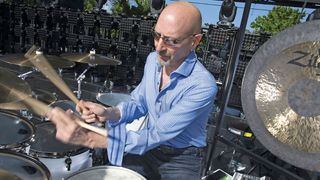
From Journey to jazz... and back again
When we catch up with Steve Smith he’s in Cologne, Germany for a week performing and recording with his jazz fusion outfit Steps Ahead and the WDR big band.
And yet just days before he’s played New York’s Madison Square Garden during his first return dates with his old partners in the classic 1980s rock band Journey. We arrange to talk again a few days later, as soon as he’s back home in New York where he has a rare couple of days’ downtime to prepare for the massive Journey summer tour, revisiting his rock star role after half a lifetime.
Steve explains, “They’ve been asking me to do it for a long time and at this point I am 61 years old and still in good enough shape. I figured I’d better do it now and not wait a few more years!”
I still have a lot of jazz gigs booked this next year and I don’t intend to give that up.
It’s always been a great story. one of the leading jazz and fusion drummers of the modern era was once an integral member of the Don’t Stop Believin’ arena-filling power-balladeers. Journey was a prime mover in the era that spawned Boston, Foreigner, Toto and Van Halen.
All bands with post- Robert Plant constricted-trousered vocalists, backed by musicians several cuts above the average rocker. Journey’s Steve Perry was arguably the best singer of his generation, with his pure soaring vocals, dubbed ‘the Voice’ by Jon Bon Jovi.
Guitarist Neal Schon with Jonathan Cain [keyboards] and Ross Valory [bass] kept Journey going with replacement singers struggling to fill the void created by Perry leaving in 1987. Since 2007, Arnel Pineda, a YouTube sensation discovery, has admirably occupied Perry’s shoes.
Steve Smith departed a couple of years before Steve Perry, having played on most of their greatest hits. He did revisit Journey briefly a decade later for Trial By Fire, but now Steve Smith is back with Journey.
Although a Berklee alumnus, already highly trained and in thrall to jazz, Smith found himself in an intriguing situation in September 1978. Aged 24 he was touring with guitarist Ronnie Montrose supporting Journey when they asked him to join, replacing the UK’s Aynsley Dunbar.
For almost seven years Steve lived the major-league rock star’s life, playing on multi-platinum albums and touring 50,000-seater arenas. Even better, the band was a collective and Steve was cut into the writing. However, he always knew his heart and destiny lay in jazz and in 1985 ‘musical differences’ led to the drummer’s exit. By now he had the ability and reputation to pursue the career he always intended.
In this he may be unique. Other great jazz-fusion drummers like Steve Gadd and Vinnie Colaiuta combine top jazz gigs with major rock tours, but as sidemen rather than actual band members. “So it is pretty unique, my place in all of this!” Steve muses with a laugh. “But I still have a lot of jazz gigs booked this next year and I don’t intend to give that up. Right now I’m in Germany recording with Steps Ahead and the WDR big band. Michael Abene has written 10 great charts of Steps Ahead tunes – and the whole band is here with Tom Kennedy [bass], chuck Loeb [guitar], Bill Evans [sax] and Mike Mainieri [vibes]. We recorded an album over the last three days and we’re going to play some jazz festivals in Germany this week.”
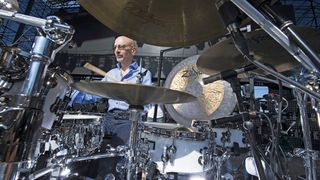
Journey revisited
It seems Steve has more on than ever. And yet here he is devoting the summer to rock touring. So, Steve, an explanation please...
"Well, for years I have been getting calls to see if I was interested in coming back. And I really was not, because I have a complete career as a band leader and featured side-man. I was not going to stop that to become a full-time member of Journey, which is what they were asking. Creatively, it’s interesting for me to visit, but it would not be satisfying long-term.
“So I’ve always said no. But last June, 2015, a unique opportunity came along when long-time drummer Deen Castronovo was let go because of personal problems. So they asked me and I was on tour with mike stern – essentially I had a whole year of bookings. So I said what if I tour next summer?
"But because they do two-year cycles – one year heavy touring and a second of lighter touring – we agreed I would make a two-year commitment. so 2016 is heavy and 2017 less so.”
I didn’t remember the original parts I played at all.
‘Heavy’ is an understatement. Steve is looking at 55 dates by September and admits, “I haven’t toured like that since the last time I toured with Journey – and that was 32 years ago!”
As the drummer on most of Journey’s biggest hits, fans will relish hearing him recreate those archetypal parts. However, he admits, “I didn’t remember the original parts I played at all. So I went back and wrote detailed transcriptions – I figured it would be best to hit ‘reset’!
"My approach is to play the tunes the way they sound best, adhering to what we did on the original recordings as a solid starting point. So I learned it all verbatim and practised a lot to memorise it. That is a key part of making the music work. When we played those tunes live in the 1980s we played them faster than the original recordings.
"That happens over time when you get a little tired of playing the same tunes every night, so you make them more exciting by playing them a little faster. That is one reason. The other is that Steve Perry wanted us to play them faster so he didn’t have to hold those [unfeasibly high vocal] notes so long! But now the group has got into the habit of playing the tunes very close to the original tempos, so they actually sound bigger, more majestic.”
Looking back at 1980s live videos, Steve was really walloping the kit. “I was playing pretty loud back then, hitting the drums hard, holding the sticks way at the back end – not really a good fulcrum, not getting a nice balance.”
Today Steve’s advanced technical skills compensate for all that youthful energy. In fact he’s been working on his left-hand matched grip and has a book/DVD out, Pathways Of Motion.
“It has absolutely helped me do a better job with Journey. I have lots more options of how to play the songs with open-handed and matched grip playing. And then I still use traditional a lot. I used traditional grip back then, but it is a lot better now. I am getting a full sound and as much energy as I need without hurting myself or beating up the kit. I don’t dent heads or break sticks.
“I came to rehearsals with my Sonor SQ2 kit...and they looked at it like, what’s up with the toy drumset?!"
"Originally I played Don’t Stop Believin’ and a couple of other songs open-handed. But now I have learned to play all the tunes open-handed, I can play them open-handed, traditional or matched grip. I have lots of options so my hands don’t get tired and I find that by switching between them I can play a 90-plus-minute set and feel fine, with no adverse effects.”
Another big change is the jump from double bass-drum pedal to double bass-drums. “I originally came to rehearsals with my Sonor SQ2 kit I have been using for 10 years, with a single bass drum, three rack toms and two floors and they looked at it like, what’s up with the toy drumset?! Whereas in the jazz world that is a big drumset.
"So I said alright, I guess I need the obligatory double bass-drums. And actually it was an easy adjustment. I like the feel of the two bass drums, the angle of the pedals. I like to sit at the drums in the most natural way and have a bit of an angle with both feet. with the single bass drum straight-on it is harder.
“I had been experimenting with three floor toms, especially playing with Hiromi and recreating the parts that Simon Phillips had recorded. I started using a third floor tom, super-low.”
There’s still the physical exertion though, coming back to stadium rock 30 years older?
“I prepared myself. I did a lot of practising before even the first rehearsal. I still have my 1980s double bass-drum set, but I hadn’t played it since then and so I practised on that a couple of hours a day. I always try to stay in good shape, but I made an extra effort. I do a lot of yoga.”
Presumably that’s now part of the modern game, if you want to keep rockin’ till you’re 80... “Yeah, well nobody thought we’d be playing rock’n’roll in our sixties and seventies, but people are doing it now! We are playing anywhere from 10 to 15,000 seaters every night. My first gig was Madison Square Garden. Our last gig is [the 41,000 seater] AT&T Park in San Francisco on September 4th with Santana, the Doobie Brothers, Steve Miller and Tower of Power – a big stadium!”
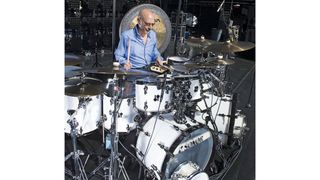
The fabric of rhythm
Along with several other high profile drummers, Steve has recently collaborated with LA art collective SceneFour in producing pictures created via playing solos with lighted drumsticks in a dark room using time-lapse photography and then transferring the images onto canvas.
Somewhat incredulously, Steve says, “I recently had an art show in NYC which was fascinating for me, very novel! When I did the art project three years ago it was a standalone project, but SceneFour had the idea of making a coffee table book with the images and that seemed like a good opportunity to make a solo record.”
Ah, yes. As someone always striving to forward the art of solo drumming, here was the ideal vehicle. “I had 13 canvasses and I thought what if I dedicate a solo for each piece and include that with the book on a vinyl LP. In fact I had 14 solos so the album has seven tracks on each 23-minute side. It’s called the Fabric of Rhythm and I’m thrilled with it.”
The first time we ever saw Steve he performed Max Roach’s The Drum Also Waltzes and Billy Cobham’s Quadrant 4. On Vital information’s 2015 album Viewpoint there is an affectionate and brilliant reworking of Joe Morello’s seminal Take Five solo.
I had the good fortune to see Max Roach perform a solo concert at the San Francisco Jazz Festival and it really changed my perspective of musicality on the drumset.
So it comes as no surprise when Steve reveals, “I’ve had it in mind to make a drumset solo album for years. Ever since Jack DeJohnette released Pictures in 1976 with mostly solo drumset pieces. It convinced me it could be done, even back then. Then recently Antonio Sanchez did the soundtrack for [movie] Birdman and I can listen to that over and over. Every one of his solos makes such a statement.”
So, of the Fabric of Rhythm, Steve says, “They are pieces I’ve been working on and playing live and I figured out how to adapt them. It was recorded in a large church [Foundation Soundstage, Ashland, Oregon] with no artificial reverb, just a beautiful big sound. It will be released with the book, 250 limited-edition numbered and signed copies in August.” You can see all the canvasses at www. stevesmithdrumart.com along with Steve’s notes on the artworks and the solos inspired by them. Although the limited edition is perhaps for minted fans, Steve says there will be a code to download the solos.
"Some of the pieces are directly inspired by the art – eg: Zen Roll is strictly a roll on a snare drum with a cymbal on the batter to get that modern electric machine sound. others are more abstract.”
The eerie Cymbalic Alchemy, for example, sees Steve, “Playing the cymbals with a stick in one hand and putting the mic right up to the cymbal edge.”
Other tracks display Steve’s phenomenal ability, but always with a musical point. Anyone who’s seen Steve live in recent years will know he’s dug deeply into the Indian vocal form Konnakol and is able to vocalise ever-more expressively as he accompanies himself on the kit. It confers structure and melody to his solos.
“That is becoming more of my vocabulary. I incorporated Konnakol in four of the pieces. Kinetic Dance is a really challenging one. I have worked on that a lot, so I can play those tihais [concluding rhythmic figures] any time I want while I am improvising. I came up with a piece in order to practise that idea.”
On Infinity Knot Part 1 Steve plays the rhythms of the overtone series from one through 12. “When you hear a note the overtones always follow the exact same pattern. First you hear the fundamental and then you hear an octave, which is twice as fast, and then you hear a perfect fifth above that, which is one third faster. So first you get one, and then you get two-over-one and then you get three-over-two-over- one, and the next thing you hear is a fourth above that which is actually another octave from the original fundamental, so that is four-over-three. Then I keep the three-over-two in my feet, and continue with five over that, six through to 12 and then 12 all the way back down again.”
Although it’s revealing to read the technical explanation while listening, the solo is far more melodically engaging than the cold mathematical description suggests. You wonder if Steve should, as Terry Bozzio did a few years ago, perform solo concerts with these pieces?
"Well that’s a good question. I don’t know. I have done some solo concerts, and find them fun. I had the good fortune to see Max Roach perform a solo concert at the San Francisco Jazz Festival and it really changed my perspective of musicality on the drumset.
"His solos were a big inspiration for my solos having some kind of hook and recognisable melody and rhythm. But then he took a snare drum out front and played an entire piece with brushes and then he played Mr Hi-Hat for solo hi-hat. I have done those as well, learned how to play standalone brushes and snare drum, and standalone hi-hat. and when I saw Max at San Francisco’s Palace of Fine Arts there were a thousand people there and they loved it.”
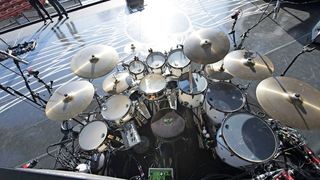
Steve's Gear
Sonor Steve Smith SQ2 kit in White Solid Lacquer High Gloss with Black Chrome hardware:
2 x 22"x14" bass drums with Vintage beech shells and modern bearing edges
Medium Maple toms; 3 x rack toms: 8"x7", 10"x8", 12"x9"; 3 x floor toms: 14"x14", 16"x16", 18"x16"
Three snare drums: 14"x51⁄2" Steve Smith Signature metal; 14"x53⁄4" Vintage beech shell and vintage bearing edges and rims with modern hardware; 12"x5" medium maple side snare; Puresound snare wires
Zildjian New Avedis line (l-r) 19", 22" with three sizzles. 15" hi-hats, 10" Flash Splash (new splash designed with Peter Erskine); 22", 14" X-Hats, 18", 20"; White Cympad Cymbal Optimisers; 34" Zildjian Gong
Remo heads – kick: Clear Powerstroke-3 with Black Dots; main snare: FyberSkyn Diplomat batter; two additional snares: White Rough Coated Ambassador batters; tom heads: Clear Ambassador batters; Vic Firth Steve Smith Signature model sticks; DW Titanium bass drum pedals; DW hi-hat pedal; Porter & Davies drum throne; Sensaphonics 3D Active Ambient In-Ear Monitors
“We’re famous for music with The Beatles... and the government is just putting importance on maths and banking": Ed Sheeran bemoans the lack of arts funding in UK schools and says he's trying to do something about it
“Watch this, he’s not fu*king around!” says Dave Grohl as Shane Hawkins plays drums with Foo Fighters during two consecutive London dates
“You can now have the sound of your favorite Nirvana record all in the computer without touching a single physical amp”: Kurt Cobain tone guru Aaron Rash releases The Utero Sessions IR Pack
Most Popular
Start believin': The story of Journey's Infinity album
By 1978, Journey had a loyal muso following but were still looking for their breakthrough. What they needed was a singer would could turn their improvisations into anthems. Cue one Steve Perry...
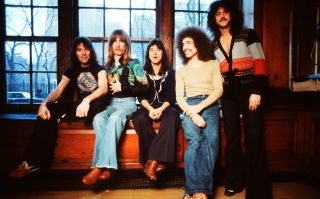
“If I had the chance I would do it all again exactly the same way,” says Steve Perry. “I swear to God. I would not hesitate for a minute.”
Steve Perry is on the phone. The commonly held notion that he’s a dark and sombre recluse couldn’t be further from reality. He’s a veritable ball of energy, dispensing charm and cheer like it was going out of fashion. Before long he’s singing down the phone, and hinting that he wants to stop kicking his heels and put a ‘section’ together (that’s old-school parlance for a band).
We’re hooked up to talk about Journey’s fourth album, 1978’s Infinity. Steve doesn’t give many interviews, but he speaks at length and opens his heart about a record that changed his life, and the course of history for his band;
a record that heralded the arrival of one of the greatest voices of our time, and set Journey on a crash course for superstardom that would ultimately result in their 1981 anthem Don’t Stop Believin’ becoming, in 2009, the best-selling song from the 20th century on iTunes (currently seven million downloads and counting).
All the facts and figures in the Journey story complete a cluster of astonishing accomplishments which are the envy of the music industry. Achievements that, in today’s music marketplace, would be almost impossible to duplicate. For a good 12 years, Journey took position at the very top of the food chain, releasing album after album of instantly recognisable songs all embellished with clear-cut hooks and melodies to die for.
These are records that have stood the test of time, and because of the musicianship inherent in each and every song they have never sounded dated. In many ways, then, Journey were not only pioneers of a style but they were also uniquely aloof – in a league of their own and a world away from the processed, hard-on-the-ears clamour of similar-sounding acts trying to carve out a slice of the same market.
When all is said and done, it was Steve Perry’s presence that really cemented the band’s reputation. Prior to his arrival Journey had been a fairly inconspicuous and mainly instrumental fusion outfit, looking to muscle in on the jazz-rock scene perpetrated by the likes of Weather Report and the Mahavisnu Orchestra.
Classic Rock Newsletter
Sign up below to get the latest from Classic Rock, plus exclusive special offers, direct to your inbox!
Great players, Journey’s early style and meticulous arrangements would, inevitably, limit their appeal unless radical changes were implemented. Their sound had attracted stellar critical reviews but, as a commercial entity, they were stuck in a rut. Not surprisingly, at the behest of their label, Columbia, changes needed to be made, a radical remodelling of the band was demanded to expand their appeal.
Infinity marked Perry’s initiation into the world of professional recording, a milestone in contemporary aural acrobatics. Within the confinement of 10 songs he effortlessly switched from breezy improvisation ( La Do Da ) to epic bombast ( Wheel In The Sky ), providing a template from which future creative diamonds would emerge, forever cementing the appeal of Journey and securing his place in rock’s vocal Hall Of Fame.
- Steve Perry on Infinity, track by track
- Journey’s Cain says it’s time for band to put Neal Schon spat behind them
- Def Leppard and Journey announce massive 58-date North American tour
Unlike the brusque delivery of British blues-belters such as Coverdale and Rodgers, Perry’s reference points evolved from diverse and somewhat unexpected sources, including the sweet soul sounds of Sam Cooke and Smokey Robinson.
Born in California in 1949, Steven Ray Perry was of Portuguese extraction. The family’s original name of Perrera was quickly anglicised to Perry when the family had entered the US, to disguise the fact that they were European immigrants (a common policy back then to improve employment opportunities). Growing up, his epiphany moment was hearing the Sam Cooke song Cupid on the radio while riding in his mother’s car. From that moment on, becoming a musician was all he dreamed of.
By his teens, Perry was a veteran of several garage bands, singing and drumming with names such as The Nocturnes, Dollar Bills, Ice (also featuring future producer Scott Matthews) and The Sullies. He even joined a Toronto-based unit called Privilege and toured Canada.
“They were a 12-piece brass group that had played in my home town near Fresno,” says Perry. “I was so blown away by how amazing they were I kept in touch with the guitar player, one of two brothers, Andy and Harry Krawchuk, and they hired me for a few months. I toured Canada with them – they were a very high-end covers band.”
By the mid 70s, Perry focused all his energies upon infiltrating the music business and moved to Los Angeles, where he formed a band called Pieces alongside experienced musicians like Cactus/Beck Bogert & Appice bassist Tim Bogert, guitarist Tim Denver Cross and drummer Eddie Tuduri. Sadly no deal was forthcoming. Bogert and Tuduri then moved to the UK to join British prog rockers Boxer.
In order to support himself, Steve took a gig as a second engineer at Crystal Studios while piecing together his next outfit, called Alien Project (the group occasionally switched to the moniker of Street Talk, which Steve later used for the title of first solo album). It was this unit that caught the ear of a couple of labels, including Chrysalis and Columbia. The latter’s A&R man, Michael Dilbeck, was hot to sign them.
The group featured drummer Craig Krampf who would later go on to become an in-demand session musician.
“Craig had some contacts in the business,” says Steve, “enough where he could pick up the telephone and call them. He was really good at hustling and got us into Chrysalis and Columbia. Michael Dilbeck was one of the Columbia people who heard Alien Project and liked it. He talked with Don Ellis who was running the West Coast office. They were thinking of signing the band.
“Back in those days, the sweetest thing that could happen was signing to a record label and making a record – that was the pathway of dreams for all of us. Michael liked the band, but I must say the demo got kind of shelved a little bit, meaning he liked it but wasn’t really moved to sign us right away. So we were kind of vacillating, thinking should we go back to Chrysalis who had been pretty excited. Then the next thing that happened was, someone at Columbia decided to go around Michael and send my demo tape to Herbie Herbert, Journey’s manager, in San Francisco.”

It’s impossible to talk about Journey without the towering presence of their manager Herbie Herbert, a bear of a man with a personality and reputation that, at times, has almost seemed to eclipse (pun intended) the band. Think Peter Grant, if he weren’t quite so intimidating and wasn’t surrounded by henchmen with fists at the ready. Herbie loved music and loved Journey. He dedicated his life to their needs and to the advancement of their career. He had a vision and nobody was gonna fuck with it, and recruiting a vocalist to the group was paramount to his plan.
In Steve Perry, Herbert had found the proverbial needle in the haystack – a vocalist with unlimited range, unique delivery and looks that killed. The consummate frontman, in fact. There is every reason to believe that Perry singlehandedly rescued Journey from interminable underachievement.
“This is where its gets complex,” Steve says, of his initial meeting with Herbert. “Herbie had already heard my name. I was mentioned to him by one of his team, Jackie Villanueva. Jackie had a friend in Frisco by the name of Larry Luciano who, as it happens, was a childhood friend of mine. We had grown up together. Larry had moved up there and become friends with Jackie and the Santana clan. That’s when he and Larry became friends with Herbie.
“Larry told him that he had a cousin called Steve Perry and that I was a pretty good singer and he should check me out. That never came to fruition until the guy at Columbia sent the Alien Project demo tape to Herbie, who saw the name and thought, ‘Steve Perry… Hmmm… Larry’s cousin?’ And of course it was. Then Herbie called me up and said, ‘I love the way you sing, I love what you’re doing and I love the band.’”
However, this budding relationship between Herbert and Perry was suddenly derailed due to the tragic death of Alien Project’s bassist Richard Micheals Haddad, who was killed in an automobile accident on the July 4th weekend. The rest of the band felt like the rug had been pulled from under their feet.
“We were due to resume talks with the labels after that weekend but, of course, it never happened,” says Perry. “I started to pack it in and called my mom to say, ‘I’m coming back home.’ It felt like the closer I got to achieving my dream, the bigger something in my life would say ‘no’. At that point I’d never been so close to someone who had died and I thought, ‘I’m not supposed to do this.’
"I was so distraught and knocked back by it all. But my mother said, no, don’t give up – something will happen. And that’s when I got a telephone call from Don Ellis, who said, ‘I’m sorry to hear about your bass player, but Herbie Herbert has your tape and he loved it. We have Journey on Columbia and we’d love you to be the singer of that band. What do you think about it?’
“I had seen Journey come to town and play many times in LA and I knew that my voice with Neal Schon’s guitar would be like salt and pepper.
"I knew that if I could ever work with him that would be a dream. It was Neal who really attracted me to that set up.”
Journey’s origins go right back to the beginning of the 70s, with the band members based in San Francisco, the centre of hippy counterculture. Keyboard player Gregg Rolie was a founding member of Santana, immortalised by the group’s stunning appearance at the Woodstock festival. The footage of Rolie trashing the living daylights out of his organ during Soul Sacrifice became iconic.
Guitar prodigy Neal Schon was also cooking up a name for himself in the Bay Area, not only as another alumni of Santana but also by working his way through a number of musical cabals, including Latin rockers Azteca and the Golden Gate Rhythm Section. Joining Journey on bass was Ross Valory and second guitarist George Tickner, both of whom were from the curiously named Frumious Bandersnatch. The band’s first drummer was Prairie Prince from fellow SF band The Tubes, but he was quickly replaced by British ex-pat Aynsley Dunbar, who had moved to the US to play with Frank Zappa’s Mothers Of Invention.
Journey’s interest in experimental jazz-fusion was confirmed on their self-titled debut album issued in 1975. A classy work, the album resonates with a surety beyond their recent formation, all players coming across as both fluid and experienced. Neal Schon in particular rips up his fretboard like combination of Jeff Beck and Robert Fripp. Check out the seven-minute long Kahoutek where he trades call-and-response licks with Gregg Rolie.
Surprisingly for such complex music, the album sold moderately well, reaching No.138 on the Billboard chart. After George Tickner bailed out of the band, their next two albums – 1976’s Look Into The Future and 1977’s Next – repeated the pattern, with Gregg Rolie making a concerted effort to deliver reasonably effective vocals atop what was clearly a jazz-fusion fanfaronade.
Despite the concerted efforts of both Columbia Records and Herbie Herbert, it was clear that Journey had reached a sales ceiling. They could continue no further in an upward trajectory unless major changes were implemented. Effectively this meant adding a proper vocalist/frontman and modifying the musical direction. It was a bitter pill to swallow but the band took it on the chin and cast their net to see what was possible.
They settled on Californian Robert Fleischman, who teamed up with the band in June 1977, at the request of label president Bruce Lundvall, who asked Robert to fly to San Francisco and see the band. Fleischman rapidly assimilated with his new bandmates, co-writing a handful of songs, three of which – Wheel In The Sky, Anytime and Winds Of March – would later surface on Infinity . Pretty much an unknown, Fleischman was, at one point, in the running to replace Peter Gabriel in Genesis for their A Trick Of The Tail album, a move scuppered when Phil Collins made a last-minute decision to step up to the microphone.
Things were moving swiftly – if not completely smoothly – when, as previously mentioned, Steve Perry’s name entered the frame. Fleischman had been out on the road with Journey during the summer, supporting Emerson, Lake & Palmer, and matters had progressed to the point where it was understood by all that Robert was their new vocalist. Behind the scenes, however, Robert had apparently been ruffling feathers. Herbie was seemingly concerned that Fleischman was unwilling to relinquish his previous manager, well-known US concert promoter Barry Fey. A reputed incident where Robert allegedly refused to go onstage unless the band played newly written material may not have helped matters either.
By now Herbie and Columbia were coming to the same opinion: that Steve Perry would be the better option for Journey frontman. Matters accelerated when Herbie asked Steve to go out on the road with the band to get to know each other. Fleischman was unaware of his diminishing status within the set up, which resulted in an uncomfortable situation. Perry’s presence in the Journey camp was explained by passing him off as Jackie Villanueva’s Portuguese cousin.
“That really only happened one time,” says Perry. “I think it was when they were playing a show at Long Beach Arena, and I don’t think Robert was actually performing with the band – he was doing soundchecks with them. I think they had pretty much told him he was going to be the singer. I was also told that internally they were conflicted about it. I said to John Villanueva [brother of Jackie, and also part of Herbie’s management team] at the Oakland Coliseum,
‘Do you think this could really happen?’ And he said ‘yes’. So I was hanging around, waiting for my opportunity.
“Actually, it should be pointed out – and I only found this out a few years later – that the label had told the band that if they didn’t get a singer they were going to drop them.”
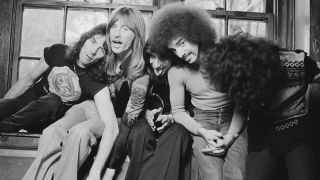
Gregg Rolie has some further insight.
“At the time Neal and I were looking for someone with more of an edge, but Herbie brought us Steve Perry,” he says. “We thought that he was a bit of a crooner and we were looking in a different direction. Robert is a great singer, but there was a lot of politics with the record company and various other things that took place there. They’re two very different singers.
“Steve actually came out on the road with us as my keyboard tech John’s cousin,” confirms Gregg. “We had to make the change, and it was a difficult thing to do, but Robert made a bit of a mistake. We were opening for ELP and he kind of made an ultimatum in Fresno, that he wanted us to play the new songs, but we were just trying to get the band across. We wanted to do the older material because it was more in keeping with the audience.
“He said he wouldn’t go on and that was a mistake on his part. Herbie made the decision right there to fire him. Nothing was really written in stone until that happened. For me, it’s now water under the bridge. I like Robert a lot and I liked what he brought to the situation. Robert has more of an edge but they’re both quality guys. It’s always a struggle.”
Did Steve feel that he had been forced upon the band by the label and Herbie?
“He [Herbie] said in essence, if not the actual words, ‘This is your new singer, deal with it,’” says Perry. “I don’t think I would have been in the band if Herbie had not just said, ‘Look guys, get used to it, keep going and shut the fuck up and write the music.’ Herbie and I have had a lot of artist/management collisions across the years.
"We accomplished so much together but it’s almost normal that artists and management have their issues. That being said, had it not been for Herbie my life would be profoundly different right now. He gave me my chance.”
Gregg: “In the end we made the right choice. Quite frankly, Herbie presented it as ‘this is your new singer’ and we were like, OK. And the fact is, he was absolutely right. Y’know, the proof is there.”
Did the band embrace Steve or were they a little apprehensive?
“You have to remember that the band had recorded three records and toured extensively,” says Perry. “Herbie was very talented in his ability to get that band to open for some very big acts – ELP and Santana – and play big outdoor shows. However, even though that was happening, they weren’t selling enough records. I think they wanted to make it on their own terms, so maybe it was a little weird for them to have to bring in a singer.
“Neal Schon was the guitar prodigy and stood centre stage. The group was built by Herbie around Neal, showing off his virtuosity. They had more of an instrumental Mahavishnu Orchestra thing going on, so it was a transition for them. Sure, I think we had our moments of difficulties with me being the new guy, so for a while I had to sort of walk on thin ice.
“It was a ‘let’s do it and see’ kind of attitude, and I had to prove myself, and I understood that, I really did. I can’t fault them for any hesitancy, because yes, they had a following before I joined them and they had fans out there that wanted the band to be successful as a fusion-based band with Gregg Rolie singing a little bit and Neal, Ross and Aynsley going off into fusion rock.
"When I joined I think they were concerned whether the fans would embrace me. Some did and some didn’t, and it was difficult walking out there. I remember one time we were in Paris I had a [camera] flash cube thrown at me and hit me in the eye.”
Gregg: “Perry wasn’t nervous, and if he was, it sure didn’t show. He knew he was good and he was co-writing a lot of the material. When you co-write, you get pretty comfortable about what you are doing, because it’s customised for you.”
How did Gregg Rolie feet about all this - he had, after all, been the band’s vocalist up until this point?
“I do believe in my heart that Gregg wasn’t that excited about the idea," says Perry, "but on the other hand he was certainly amenable and open-minded. We wrote Feeling That Way together, sharing vocals, and that was cool. In fact that’s the song where I would walk out on stage.”
From Gregg Rolie’s perspective, the situation was clear. “I expected to still sing a couple of songs here and there, but Steve was our lead singer,” he says. “I was stretched pretty thin playing four keyboards, harmonica and singing lead. With Santana I was the lead singer, and with Journey I was lead also. So, I’d never shared vocals before.
"I wanted to continue to do that – I looked at it like, well, The Beatles didn’t do so bad with four singers. So the more the merrier, and I still feel that way about it, but it just slowly got to be less and less.
“Eventually the band got built around Perry,” Gregg continues. “He came in at it slowly and it evolved into this situation where we were writing songs for an actual lead vocalist, which is totally different from where early Journey and Santana came from. Back then we had vocals, but it was really about the solo work and then, slowly, it became more about the lead vocals. It was great for me because I became a much better songwriter.”
It was the beginning of a new chapter for both of them. Blessed with an appealing personality, good looks and a voice from heaven, Perry soon became the focal point of attention. It was now time to unleash his talent in the studio by recording Journey’s fourth and pivotal album, Infinity .
The plan was simple: write songs, hire a producer, select a studio and make an album that would set out their stall for the next 10 years or more. Steve immersed himself in songwriting with all the band members, but mainly with new creative partner Neal Schon, eventually securing co-writing credits on eight of the 10 songs.
Steve and Neal struck up a strong rapport and quickly established a beachhead, strengthening the band’s sound and setting in place a new direction. The emphasis was now on fully formed songs with melodies, hooks and the sort of contemporary buff that made the competition quake in their boots.
The choice of producer was inspired. Band, management and label all agreed on Roy Thomas Baker, the flamboyant British studio craftsman who had worked with some of the most influential rock bands around, including Free and – most importantly – Queen.
After seeing the band live in Santa Monica, RTB (as he is affectionately known) and his trusted engineer Geoff Workman rendezvoused with the band at His Master’s Wheels Studio (formerly Alembic Studios), located on Brady Street in downtown San Francisco.
“They put me in a little apartment on Bay Street,” remembers Steve. “I went to SIR [Studio Instrument Rentals, a well-known rehearsal room] every day and wrote songs with band.
“Then, all of a sudden RTB comes in. We had enormous respect for him, because he’d produced Queen and Free. He was so much fun. The studio [His Master’s Wheels] had an old Neve console and a large tracking room, and the next thing you know he was really giving us a different sound.
“Neal’s doing what we called ‘violin guitars’. Roy had me stack all the vocals on a 40-track machine, and I really enjoyed that process. Also, Geoff Workman was so instrumental that we ended up grabbing him to do one of the records [ Departure ] without RTB.
“We rehearsed the material quite a bit before we recorded it so everything was ready to go before Roy got there. What Roy gave us was the opportunity to try different textures and ideas, but the foundational aspect of the songs and the arrangements were done. He really gave us a direction, and from there the band found itself.”
“I have fond memories of working with Roy and Geoff,” says Gregg. “Roy was very into experimentation, and quite wild in the studio. The multi-tracking of guitars and vocals was a brand new thing for us – all the layering. It was intense work. He created a sound which a lot of the guys didn’t like because it was so edgy, but I happened to dig it.
“Those tracks had a specific sound to them, which is what a good producer does. He was, and still is, a real character. Him and Workman both – they were fun to be around. Workman did a lot of the heavy lifting, inasmuch as getting things done.
“Geoff had worked with Roy for a long time and knew what he wanted. If Roy disappeared for a couple of hours, Geoff just carried on because he knew what they were doing as a team. We used the same team on the next album, Evolution . It got us on the map.”
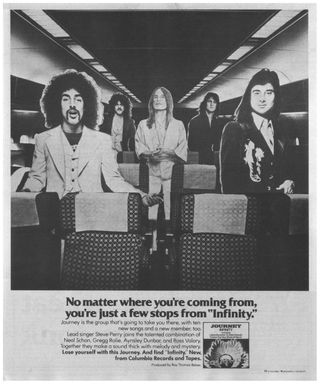
Not surprisingly, the biggest impact was the quality and strength of Steve Perry’s vocals.
“I certainly discovered the depth of multi-tracking, as I never had a chance to work on a 40-track machine before,” says Perry. “I’d never had the ability to do eight root notes and then bounce them to one track, then wipe those and do the eight thirds, wipe those then do eight fifths and eight octaves and so on – and suddenly you have a big stack like on Anytime . When they are layered and smeared tight they just really block up. Roy knew how to do that.”
But despite the good vibes and enthusiastic progress, the glue soon came unstuck when a studio prank backfired…
“One night we went out for sushi and drank a bit of Sake,” laughs Steve. “Roy drank a little bit more Sake than most of us, along with a couple of the road crew. When they got back, Scotty [Ross, roadie] remembered a story about how Roy had once chased Freddie Mercury around the studio with a fire extinguisher.
“So Scotty decided to be funny and grabbed one of the studio extinguishers and chased Roy. Then Roy grabbed an extinguisher to reciprocate and fired it off, but it was one of those dry chemical types. The next thing we knew was that we couldn’t breathe – it had sucked the oxygen right out of the room and we couldn’t see in front of us for the smoke. So we ran outside thinking, ‘Oh my God, what the hell happened there?’ After a while we walked back in and the place looked like it had snowed, everything was covered in white powder. The problem was that the console, the recording tape and everything had this fine, very abrasive powder all over it.
“The Neve console was ruined. We had to quickly remove the tape because the dust would eat the oxide, so we moved to Cherokee Studios in Los Angeles to finish the vocals.”
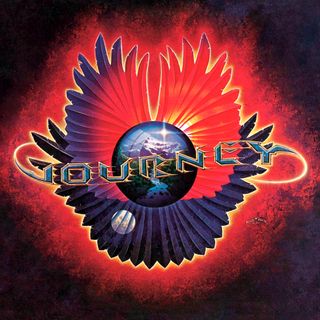
With the album completed, a design makeover followed. The band brought in renowned San Francisco artists Alton Kelley and Stanley Mouse (real name Stanley George Miller). The duo had first hooked up with San Francisco’s counter-cultural doyens the Grateful Dead (designing their album covers) and legendary West Coast promoter Bill Graham (designing his gig posters). During the early 70s they had formed the Mouse Studio, and helped rebrand Journey by designing and standardising their cover art, including Infinity’s colourful flaming wings. The pair also came up with a Journey logo.
Says Perry: “Bruce Lundvall was the president of Columbia at the time, and he quipped that, in order for us to make another record with me singing, we would have to sell one million units. Hence the reason we stayed on the road for 298 shows that year. We started touring in February and didn’t come home for almost a year.
“ Wheel In The Sky was the first single. Neal and I went to a pizza place, and I went over to the jukebox and saw a Wheel In The Sky 45 in that machine – an ecstatic feeling. I didn’t tell Neal, I just put two quarters in, pushed the button and sat down and the song started. Neal looked at me and started laughing. It was a monumental moment. Back then if you were starting to show up in jukeboxes it was a sign that you might be finally starting to happen. My mom had an eight track in her car and she would play the cassette to everybody saying, ‘That’s my Steven.’”
Although the tour emphasised the band’s growing stature, it also highlighted that while Aynsley Dunbar was an exceptional rhythm king, he was perhaps too complex for the way Journey’s music was developing.
“Van Halen were the opening act on the tour,” remembers Steve. “They were a brand new band back then. We were doing 3,000-seat auditoriums and they were killing us every night. It was eye-opening. We were keeping up with them, but they were certainly making us be a better band. They were so musically simple.
“Well, I was a drummer before becoming a singer and one of the things about being a drummer is that I’m kind of hard on other drummers. Foundationally you can have a really great band, but if the drummer doesn’t measure up you’re not going to do very well. But if you have a mediocre band and a great drummer you’re going to do better. So we’d do soundchecks and sometimes Aynsley might not be there or be off doing something like radio promotion and I would do soundcheck for him – set his drums up and play a few songs. It started to be apparent to Neal and to myself that the band sounded different with me because I’m a slamming R&B-style drummer, as opposed to a jazz-fusion drummer like Aynsley.
“Aynsley’s style had been perfect up to when the band changed style. As the music evolved, we started to work up some of our new ideas with me playing drums, and they didn’t sound as good with Aynsley playing them. So we toyed with that for a while, but occasionally we kept being reminded about it while jamming new ideas for the follow-up record. And then we saw Steve Smith playing drums with Ronnie Montrose, who was also one of our support bands, and we thought, ‘Help, what do we do now? Because this guy sounds like the cat.’ We started hanging out a lot – the next thing is we made a switch.”
Journey’s run of success continued with their follow-up albums, from Evolution through to blockbusters such as Escape, Frontiers and Raised On Radio .
Their continued uphill trajectory was an unprecedented triumph, propelling the band into increasingly larger arenas and stadiums, right the way through to the late 80s, before they implemented a (theoretically) indefinite and somewhat strained hiatus. With hindsight, the appointment of Steve Perry and the creation of the Infinity album was one of the pivotal moments in the development of modern rock.
“I liked the songs, I liked the edge and I liked the dual vocal stuff,” reflects Gregg Rolie. “The band had a lot of colour to it and I think we could have explored more of that. Infinity for me personally was a big change; writing songs for singing rather than writing songs for playing. The addition of harmonies and multi-track vocals… we’d never sung harmonies like that before.
“Also, the songs were great: Patiently, Winds Of March, Lights … Later it started going away from where I thought it should have been, but I’m only one member of the band so you’ve gotta roll with it. On Infinity there was still solo and instrumental work influencing how it sounded – it still had that vibe of being alive. It was always powerful. We actually carried that edge into the Evolution album.”
“If I had the chance I would do it all again exactly the same way,” says Steve Perry in conclusion. “I swear to God. I would not hesitate for a minute.”
Journey are on tour now. This article was first published in Classic Rock presents AOR, issue 11
Derek’s lifelong love of metal goes back to the ’70s when he became a UK underground legend for sharing tapes of the most obscure American bands. After many years championing acts as a writer for Kerrang! , Derek moved to New York and worked in A&R at Atco Records, signing a number of great acts including the multi-platinum Pantera and Dream Theater. He moved back to the UK and in 2006 started Rock Candy Records, which specialises in reissues of rock and metal albums from the 1970s and 1980s.
“I imagine there’s more unlistened to copies of Killtaker than any other Fugazi album.” Nirvana may have brought 'alternative rock' to the masses, but for Fugazi, America's greatest punk band, the fall-out proved to be “a real nightmare”
"At times you can barely hear Gallagher over the roar of the crowd." Liam Gallagher's Definitely Maybe tour comes home to Manchester, and it's magical
“How VIP do we gotta get? We need another hit guys!” That time Paul McCartney, Taylor Hawkins, Beck and Woody Harrelson got refused entry to a music industry party in Hollywood
Most Popular

Weirdo Wednesday – Matt Stone, Trey Parker, Ween & Primus Salute America at Red Rocks

LISTEN: Robert Sesma Delivers Lush Pyschadelia Via Captivating Guitar Styles On “Temporary Thing”

LISTEN: Hamish Anderson’s “You’re Mine” Blends Bluesy Tropes With Searing Guitar Prowess

Tuesday’s Gone Violent Femmes Keep Hope Alive With “American Music” Live 1992

North Mississippi Allstars’ Cody Dickinson Celebrates A New Way Of Life With First Solo Album ‘Homemade’ (INTERVIEW)

Philly Rockers Cosmic Guilt Finds Perspective With ‘Palace Of Depression’ (INTERVIEW)

Karen Haglof’s New LP ‘One Hand Up’ Is a Wild Multi-Genre Ride (INTERVIEW)

RJD2 Details New Album ‘Visions Out Of Limelight,’ His Twenty-Plus Year Career & Starting His Own Label (INTERVIEW)
Album Reviews

Soundtrack to Joss Whedon’s Cult Classic Space-Western ‘Serenity’ Gets Vinyl Release (ALBUM REVIEW)
Show Reviews

Drive-By Truckers Tackle Landmark Album ‘Southern Rock Opera,’ Cover Neil Young in Explosive Portland, OR Performance (SHOW REVIEW/PHOTOS)
Television & film.

Music World Gives Payback To An Overlooked Legend On ‘Lee Fields: Faithful Man’ (FILM REVIEW)
DVD Reviews

1982’s ‘Around The World’ Covers The Police On Their First World Tour (DVD REVIEW)
Other Reviews

Kathleen Hanna Shares Deep and Introspective Stories in Memoir ‘Rebel Girl: My Life as a Feminist Punk’ (BOOK REVIEW)
Film Reviews

‘Licorice Pizza’ Can’t Carry Weight Of Its Parts (FILM REVIEW)

‘Loki’ Gives Us Loki vs. Loki in Episode 3 (TV REVIEW)

All the Movie Trailers from Super Bowl LIV
Commentary Tracks

2021 Holiday Movie Preview: ‘Ghostbusters: Afterlife,’ ‘The Power of The Dog,’ ‘House of Gucci’ & More

25 Years Ago Today -Mark Sandman of Morphine Dies On Stage At 46 (Watch Final Interview)

SONG PREMIERE: Death Doula Offer Dreamy Indie Rock Reflections on “Dory Joins Alfred”

The Revolution Jam Like It’s 1984 Again At Minneapolis’ First Avenue For ‘Purple Rain’ Anniversary Week (PHOTOS)

John Fred Young Of Black Stone Cherry Serves Up Another Round of Candid Hard Rock Insights (INTERVIEW)

45 Years Later- Neil Young & Crazy Horse Ensure Rock and Roll Can Never Die With ‘Rust Never Sleeps’
Vinyl Lives

Portland’s Record Pub Serves Up Vinyl, Brews & Weekly Gatherings (VINYL LIVES)
These Walls

Richmond, Virginia’s The Camel Keeps It Artist-Driven & Creatively Spirited (These Walls)

Saxophonist John Helliwell (Formerly Of Supertramp) On A Life Of Jazz After Prog-Pop (HEY YOU/INTERVIEW)

On The Map: Inside The Allman Brothers Band’s ‘Big House’ In Macon, GA
Vintage Stash

The Replacements’ ‘Tim’ Let It Bleed Edition Proves Worth As Discerning & Durable Retrospective

TIME OUT TAKE FIVE: Falkner Evans, Franco Ambrosetti, Jan Hammer & More

SONG PREMIERE: Darren Barrett Lays Down Sprawling Instrumental Funk Single “The Clav Is In Order”

SONG PREMIERE: Heart of Pine Ignites & Takes Notice With Fiery Country/Blues Rocker “Hello Heartache”

SONG PREMIERE: Michael Des Barres Serves Up Rock ‘n’ Roll Cover of Roxy Music’s “Love is the Drug”

- May 22, 2023
- Interviews , My Roots
Drumming Legend Steve Smith Talks Vital Information’s New Album, Making Jazz His Home Base & Past Journey Triumphs (INTERVIEW)
Photo by Alejandro Padron
- By Leslie Michele Derrough
- No Comments
Steve Smith was nursing a little tour fatigue when he called in for our recent interview. He had been out on a short run with his band Vital Information, a Jazz ensemble he has been recording within various incarnations since 1983. Although he is widely known in the rock & roll world as the drummer on some of Journey’s most popular hits – “Don’t Stop Believin’,” “Separate Ways,” “Any Way You Want It,” “Faithfully” and “Who’s Crying Now” – Smith has always called Jazz his home base. As a pre-teen growing up near Boston, he took drum lessons from a local Jazz teacher. He toured with renowned Jazz violinist Jean-Luc Ponty before hooking up with Ronnie Montrose for his solo tour. Jazz was there in his playing then and it’s there now. It’s his passion.
Smith has certainly made a name for himself in the Jazz world. His band Vital Information just released their 17 th album, Time Flies , and it’s a sparkler. If you’ve never heard Smith play Jazz, you’re in for a treat. With Janek Gwizdala on bass and Manuel Valera on keys, the trio weaves in and out of intricate heartbeat rhythms and sassy time signatures. The title track is a masterclass in what clicking together in all the right moments can sound like; “Self-Portrait” begins with a lovely tranquil piano intro that rides itself all the way through; while their interpretation of Thelonious Monk’s “Ugly Beauty” is almost a dream come true. Jazz may be an acquired taste, especially for those die-hard rock fans not used to more complicated improvisations, but it’s always worth going to the roots of your favorite musicians to see how they incorporated their inspirations into rock & roll. And Steve Smith had a lot to share with us about those methods, in Jazz and rock.
How old were you when you really started to understand what Jazz is about?
I started drumming in 1963, which at this point is now sixty years ago (laughs). I was nine years old in 1963 and that was when I started drumming. I started by taking private lessons. My parents found me a teacher near this little town I grew up in, Whitman, Massachusetts, and there was a drum teacher in Brockton, Massachusetts, and which is about twenty-five miles south of Boston. When I went to that teacher, Billy Flanagan, he was a Jazz drummer and it was pretty common in those days that if one was to study drums one would study with a Jazz teacher because rock was not as popular as it is now, or was to become shortly after that time.
All the teachers were Jazz drummers so by the time I was about twelve, I was very into Jazz. So it coincided with my drum lesson from a Jazz-oriented drum teacher and then my own listening of what appealed to me. And what appealed to me musically in those days was Big Band Jazz: Buddy Rich Big Band, Stan Kenton Big Band, Count Basie, Maynard Ferguson. And all of these bands were on tour at that time and living in the Boston area and I got to see all of those bands perform. So that was very exciting for me as a young musician growing up.
So my roots in Jazz go back to the beginning of me starting drumming in 1963. It wasn’t until around 1967 and 1968 that I actually started to get an interest in rock music and that came about because I heard the drummer in Jimi Hendrix’s group, Mitch Mitchell, and he sounded like a Jazz drummer to me, so I could relate to him. Then I heard Cream with Ginger Baker and then Led Zeppelin with John Bonham and I could relate to their Jazz-oriented approach to rock drums. So by the end of the sixties, I really had a record collection that was equal parts Jazz and equal parts rock, which of course then lead to the next musical development that came along, which is the combination of the two, Jazz Rock Fusion, which literally is putting together Jazz and rock and creating a music that has elements of each. That’s how far back it goes for me.
When you hear Jazz drumming in other players, what exactly do you hear?
It’s like a swing approach, a very triplet-oriented approach. Like if you listen to Jimi Hendrix and listen closely to the drumming, Mitch Mitchell could have been playing in a Jazz group. And that approach of the Jimi Hendrix Experience was very Jazz-oriented. They weren’t playing strict beats. The drums were loose and interpretive and Mitch Mitchell would comment, let’s say, on what Jimi Hendrix was doing in a way that is what happens in Jazz. And that’s just one example. With John Bonham with Led Zeppelin it was also free, it was loose and swinging with a lot of triplet-oriented feels and fills.
If you had never done rock & roll, what do you think your drumming today would be missing?
(laughs) I don’t know. What I can tell you is the fact that I did play rock music and it brought a compositional element to my drumming. One of the things I learned by playing rock was that I needed to come up with drum parts that were devised in order to play songs, which is a different approach than interacting with musicians in a way that is based more on improvisation. So the rock drumming brought a compositional approach to my drumming.
For Time Flies , how did you want it to be different from the others you’ve recorded with Vital Information?
One thing that’s very different on this album is that the group is a trio and in the past, my groups have been a quartet or a quintet. I’ve had either guitar, keyboards, bass and drums or guitar, saxophone, keyboards, bass, and drums. Or from the first album, it was saxophone, two guitars, bass and drums. So having a piano-oriented trio is a very different approach for my Vital Information group and that evolved in a kind of natural evolution that it became a trio. It actually happened in 2020 and through a variety of influences, one of them being covid and the fact that I was doing some touring but not all the band members could make it to Australia. I had a week in Australia and I took Manuel Valera on keyboards, the keyboard player on Time Flies , and nobody else could make it so I used a bass player that I met in Australia and we played as a trio for a week in a club called Bird’s Basement in Melbourne, Australia. And I was surprised but pleased that it went so well and the group really sounded very good. Manuel Valera did an amazing job playing all the melodies and the chords and soloing and the group sounded very complete as a trio. So after that, which was March of 2020, we had to come right back to the US and everyone was locked down in the music world, and the rest of the world. But that’s when I decided to continue on as a trio cause it worked so well.
Something good came out of something bad
Yeah, it was interesting and when it came time to record the album, I knew that I wanted to go in that direction. And I knew the bass player I wanted to use, Janek Gwizdala. I had toured with him before in some other groups where we were both sidemen and he had done some work with Vital Information when my bass player had some health issues and couldn’t play. So I knew he would be the perfect bass player for this endeavor. Not only is he a great bass player but he’s a great soloist. And when the group is only three people, everyone has to be a strong soloist in this environment, and that way all three of us can be expressive and play an evening’s worth of music that stays interesting.
What is the biggest difference when recording a rock album versus a Jazz album? Is there a difference?
Yes, there is a difference between recording a rock album and recording a Jazz album. In both cases, the drums are the foundation of the music but with a rock album, the drums give the compositional structure to the music and generally, there is not much in the way of improvisation. That is more, let’s say, a result of rock being more composition-oriented. Especially in the last twenty to thirty years, rock drumming has become MORE along the lines of being very compositional because so many composers use drum computers to write their music and they get very attached to the drum parts they come up with. As a session drummer, I’ve done a lot of rock session work, many times I end up literally reproducing the drumming that is on the demo that somebody comes up with. That’s very different than what I was discussing with the rock in the late sixties, Mitch Mitchell and Ginger Baker and John Bonham and another drummer I really loved in those days, Ian Paice with Deep Purple. The music was freer than it became in those years.
Recording a Jazz album, the drums are just as compositional and the foundation base but there is a lot of room for improvisation and interaction with the other musicians. In fact, if I played the same beat all the way through a Jazz tune, that would be very static sounding and it wouldn’t have the element that makes Jazz very listenable and enjoyable, as far as I’m concerned. It’s that interaction with all the musicians and how the drummer interacts with the bass player, the keyboard player, and in other cases, this new Vital Information record, let’s say, interacting with the saxophone player. Actually, there is a saxophone on this album, just not on all of the songs. George Garzone plays on some of the music as well as Mike Mainieri plays vibes on one of the songs [“No Qualm”]. So there was that opportunity to interact with those musicians as we recorded. That’s a very different approach, where there’s a demand for freedom and a loose approach to the music.
What about when you’re preparing for a tour? Is it more time-consuming to do a Jazz tour than a rock tour?
No, they both take time to learn the music. When I prepared to do Journey tours, say from 2016 to 2019, when I relearned those songs that I hadn’t played in over thirty years, that took a lot of work to memorize quite a few songs (laughs). When I prepare for a Jazz tour, also it takes a long time to learn the music because when I’m in the studio with Vital Information, I’m reading music as I record it, because we’re playing songs that were brand new, that we hadn’t recorded before. So I read while I’m in the studio. But for live, I want to memorize everything. So it took me, I’d say, about three weeks to memorize all of the music so when I did the tour that we just did – we just did a West Coast tour – I was prepared and didn’t read music for the tour, which I think it looks better onstage and I’m also a little more free as I don’t have to be reading music while performing it live.
Are you more comfortable in improvisational mode versus a more regulated structured situation?
Sure, I do prefer the more improvisational situation. It’s a preference. I can do the rock drumming and I am capable of doing it, and while doing it I am doing it because I know how to do it and I devote myself to that craft. But given a choice, my preference is playing Jazz and playing with Jazz musicians. I have more in common with them, as far as background, my approach and my love of music. I resonate more with the Jazz musicians.
For the title track, “Time Flies,” what was the conception of that?
Really what happened with that is that trio had been in the studio before George Garzone arrived and we had recorded the Bud Powell tune, “Tempus Fugue-It” and simply suggested, let’s play something that’s harmonically related to “Tempus Fugue-It,” but it’s a simple groove, something that we can put either before or after it. Tempo-wise, I wanted it to be about half the tempo of “Tempus Fugue-It.” And that’s exactly what we did. I just counted off a groove, counted off a tempo and the four of us improvised and what you hear is that improvisation that we just came up with in the moment; just played it one time and it felt great and sounded good to us so we moved on.
“Self-Portrait” has the beautiful classical piano intro but I understand this is actually a tune that goes pretty far back with you.
Right. The composer of that tune is Mike Mainieri, who is the band leader and vibes player for a group called Steps Ahead, and in 1986, I became a band member of Steps Ahead and one of the songs that we were playing was that tune, “Self-Portrait,” and I’ve played it over the years. Once I started playing in Steps Ahead, I continued to play with the group on and off, and actually right up until 2019, the last gig I played with them. Mike Mainieri would sometimes use a different drummer, different bass player, different sax players and so he’d call me for some tours, wouldn’t call me for other tours, so it’s actually a very good situation to revisit the music and play that music at different periods in my life and musical development. So that is a beautiful tune and it was actually the idea of Manuel Valera to play that song and it was one of the songs that we started playing in Australia during our week down there. And again, it just sounded so good we continued to play it when we started playing live gigs again.
Then both Janek and Manuel wanted to record it on the album. I wasn’t even sure if we should record it (laughs). It’s been recorded a number of times but they really insisted and we played a beautiful version of that. I’m really happy with the way it came out. Then of course I invited Mike Mainieri to play on a song but not that song. He plays on a tune called “No Qualm,” which I felt like was a really perfect showcase for him. In some ways that song reminds me of some of the Steps Ahead music and therefore it seemed the perfect choice to have him play vibes on that with us.
You do Thelonious Monk’s “Ugly Beauty” and you’ve covered him several times on record before. What resonates from his music with you?
I’ve actually played a lot of Thelonious Monk’s music but mainly in New York in the Jazz clubs in live situations. The music is very challenging and lends itself to very open improvisation and very open to interpretation. But one of the reasons I’ve recorded Monk tunes over the years is because the band members in Vital Information have liked the music and come up with interesting arrangements and brought them to the group and so we’d play them. Like Mark Soskin, who was the keyboard player on the last few records, he brought in “Rhythm-A-Ning,” and I can’t remember what the other Monk tune was, but he brought in some really great arrangements. And just like on this album, Manuel came up with the really innovative arrangement of “Ugly Beauty,” because the original tune is in ¾ and he came up with a 5/4 interpretation of “Ugly Beauty.”
Where have you been in the world where they seem to really appreciate the drums and highlights them over other instruments, in your opinion?
Well, if I only have to choose one country, I would say India. There is such a highly developed drumming culture in India. In North India, the main drum is the tabla, and in South India it’s mridangam and kanjira and ghatam, which is a clay pot. There is such drumming traditions that drummers can play solo concerts or concerts where two or three drummers play together. I’ve been to India quite a few times and witnessed 2000 to 3000 people watching solo drum concerts and just loving it. And when I have toured there, I have experienced it, the extreme openness and appreciation of drumming and rhythm, sophisticated rhythm.
In your career, what has been the most difficult song you’ve had to transfer to the live stage?
I can’t say there’s one particular song because in every tour that I’m hired to do there will be particular tunes that may take more time to learn than others but once I learn it then I have it. But I will say, and I can’t remember the exact year, but I think it was like the early 2010s – 2011, 2012, 2013, 2014 – and I toured with a pianist named Hiromi and she is a virtuoso Jazz pianist. Some of her music was very difficult to learn and perform live. That was some of the hardest music that I’ve ever had to learn. The names of the albums that I played on were called The Trio Project . I didn’t play on the studio recordings – a drummer named Simon Phillips played on the studio recordings – but I did a lot of the live shows and that was pretty difficult music to learn. But it was quite satisfying, learning hard music and then playing it well. It is very satisfying.
Was it intimidating coming into Journey and taking over for Aynsley Dunbar?
It was not intimidating taking over for Aynsley and I really like Aynsley’s drumming. He’s another one, as I was describing, like Mitch Mitchell and Ginger Baker, that I think comes from a similar Jazz/rock orientation and his drumming on the early Journey albums is really fantastic and very appropriate for those records. But I had been on tour with a guitarist named Ronnie Montrose and we opened for Journey for three months so I got to hear Aynsley play every night and then we became friends. I definitely have a lot of respect for Aynsley and his drumming. But coming into the group, I was not thinking about taking his place as much as I was thinking about bringing something new to the music. So I wasn’t trying to play in his style or play in any way related to the way he played. I was coming in with a new concept and that was my focus.
You mentioned Ronnie Montrose. What did you learn from him about being a band leader?
Ronnie was a very relaxed type of band leader and he didn’t give us a lot of direction. He let us come up with the way that we wanted to interpret the music and I think that he allowed us a lot of freedom. So that was somewhat new to me at that time. I had played with a lot of different groups coming up but I had not toured on that professional level very much. The band leader that I was working with right before that was Jean-Luc Ponty, the French fusion violinist. He had a lot of ideas of how he wanted his music performed. So he gave more direction to the band members, and rightly so, cause he had written this very sophisticated music and he wanted it performed in a certain way. But Ronnie was a lot looser than that, and in fact the music was a little looser so it all made sense, it all worked together.
You played on Richie Kotzen’s first album. Tell us about that experience because that was Shrapnel stuff, the ultra fast stuff.
Yeah (laughs). The owner of Shrapnel Records, Mike Varney, was a friend of mine and he was someone that I knew when I was living in northern California. He hired me to play on some of those records, like Tony MacAlpine’s record, and I was able to do that, to adapt my playing to that style and that kind of music. And what Mike Varney did, how he found Richie Kotzen and how he found these various guitar players is he wrote a column for Guitar Player Magazine in those days and young players would send him cassette demos of them playing and he’d write about them in the magazine. But it also gave him the idea, well, maybe I should make an album of this guy. That’s how he started that label and Richie Kotzen was one of those young guitar players that he signed to his label.
When Richie came to California to do the album, he came with his parents cause he was seventeen years old. So his mom and dad were at the session and he was very gifted and highly-developed for his age. Stu Hamm was the bass player on that and the tunes were in some ways quite unorthodox because Richie would have some odd bars; some of them were actually out of time that he conceived so it wouldn’t be in strict meter. I remember it was not an easy session (laughs). There were a lot of details we had to learn for that music and we didn’t have much time because those Shrapnel records were quite low budget records. We usually made them in about one or two days. So we would rehearse, we rehearsed at my house, I had a home studio, and I know we rehearsed there for a couple of days to learn the music and then went into the studio and recorded it. It was an interesting experience.
Of all the Journey albums that you played on, which one top to bottom do you feel you were on point and locked in at your highest potential?
Actually, the album Trial By Fire , the last one that we recorded with, let’s say, the classic Journey lineup. It doesn’t get a lot of attention but I really like that album and my drumming at that point had evolved a lot since I had made the albums Escape and Frontiers , the earlier Journey records. I had just done a lot of work on my playing and so when we went into the studio to record that album, my drumming was at a new place. And I’d done a lot of work technically to develop my technique to get it to be more fluid and smoother. Then I also had done a lot of studio work in the interim between 1985 and 1995 or 1996 when we made that record. So I’m really happy with my performance top to bottom on Trial By Fire .
Did you record the first Vital Information album before or after you finished Frontiers ?
It was after, as far as I can remember. We recorded Frontiers probably near the end of 1982 and then in January 1983, I recorded the first Vital Information album and then shortly after I recorded that album, Journey went on tour to play the Frontiers music. Then in the fall of 1983, I toured the US with Vital Information, the early incarnation of Vital Information.
Was your core goal to be Jazz and not so much rock?
My career has always, in my mind, been about playing Jazz. But I’m pretty open-minded so when I had the opportunity to record rock, I’ve been able to do it and I enjoy doing it. But my preference if I’m going to go on tour and play music live, I want to play Jazz. And it’s not just with my band, it’s as a sideman and I’ve worked with a lot of great Jazz musicians as well. Like, I’ve already mentioned Steps Ahead and Hiromi. I’ve toured a lot with Mike Stern, a great guitarist. So my preference of live music is to play Jazz music, because it’s just a lot of fun for me. To play rock music live is a particular challenge but for the most part I’m recreating something that’s been recorded and the drum parts that I’m playing are more structured and need to be played very close to the albums night after night and that has it’s own challenge. But given the choice, I’d rather play much freer every night.
And what is the rest of your year looking like?
There is a tour of the East Coast in June, a Vital Information tour, and then the next thing that I do musically after that will be playing in the Jazz clubs in New York City in September and October. Mainly I’ll be playing at Birdland with some various all-star groups. And all that should be posted on my website, https://www.vitalinformation.com
Related Content

Journey & Toto Bring Arena Rock Splendor To Los Angeles (SHOW REVIEW/PHOTOS)

2013 Music Midtown Festival – Friday (Recap)
Tour dates: down and dirty, leave a reply cancel reply.
Your email address will not be published. Required fields are marked *
Recent Posts
New to glide.

SML Break New Ground with Experimental Jazz Sounds on Debut ‘Small Medium Large’ (ALBUM REVIEW)

Austin’s Nick Taylor Gives Hearty Track By Track On Stellar Debut Album ‘Not Alone’
Keep up-to-date with Glide
Email Address*

- On the Cover
- Gear Reviews
- Departments
- Legends Collection
- Carmine Collection
- Merchandise
- Festival 2021
Steve Smith’s Acceptance Speech During Journey’s Induction Into the Rock and Roll Hall of Fame

At Journey’s induction into the Rock and Roll Hall of Fame this year, drummer Steve Smith took the opportunity to, as we say, give the drummers some. “My speech was drummer-oriented,” Steve tells Modern Drummer, “as I wanted to be clear about my influences and my drumming concept for Journey’s music.” Here’s what Smith said on the night:
“Rock ’n’ roll means many things to many people, as the diversity of the Class of 2017 clearly Illustrates. I started out in 1963, at nine years old, as a jazz drummer. I thank my parents, Bruce and Lorraine Smith, for finding me an excellent private drum instructor and supporting my musical passion.
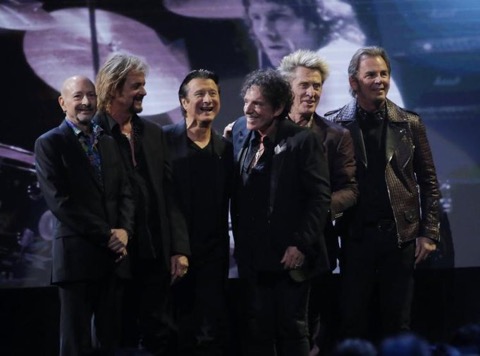
Journey members Steve Smith, Gregg Rolie, Steve Perry, Neal Schon, Ross Valory, and Jonathan Cain. (Missing: original Journey drummer Aynsley Dunbar, who was giving his speech when this photo was taken.)
“Disc jockey Alan Freed—a Rock and Roll Hall of Fame inductee—once said, ‘Rock ’n’ roll is really swing with a modern name. It began on the levees and plantations, took in folk songs, and featured blues and rhythm.’ He said this in the 1950s. Now that we live in a global community, more influences have been added to, and will be added to, the definition of what is rock ’n’ roll.
“For me, one of the most explosive shifts in musical direction came in 1971 with the creation of the Mahavishnu Orchestra with John McLaughlin, Billy Cobham, Jan Hammer, Jerry Goodman, and Rick Laird. With drummer Billy Cobham, and, a couple years later, Narada Michael Walden stepping in to the Mahavishnu Orchestra, jazz officially rocked! In many ways, that funk-rock, jazz-fusion drumming concept was the template for my work with Journey.
“Thanks to my children, Ian and Elizabeth, for keeping me in their hearts while I was away on long tours. And very special thanks to my wife, Diane. We have been sharing our lives for the last twenty-four years, I love you dearly. Thanks to Jonathan Cain for the gifted songwriting and Arnel Pineda for keeping the legacy sound of Journey alive and moving forward. And a most important thanks to our fans from around the world that have kept Journey in their hearts and on their stereos.”
Latest Posts
Episode 140: my top 10 most influential albums with mark guiliana.
September 14, 2023
Episode 139: My Top 10 Solo Drum Albums with Glenn Kotche
September 7, 2023
Ep.11 – THE NEW BREED HORIZONS – Gary Chester-inspired drumming concepts with Corey Roberts
October 27, 2022
Ep.10 – The New Breed PUNK’D with Chris “Tomato” Harfenist
Punk legends unite at goldenvoice’s no values festival.
June 18, 2024
New Orleans Jazz & Heritage Festival 2024: Second Weekend Highlights

Complete List Of All Journey Current And Former Band Members

Feature Photo: Bruce Alan Bennett / Shutterstock.com
I first fell in love with the band Journey when I was in high school and brought the band’s album Infinity when it was first released. Their record company Columbia Records at the time heavily promoted the album. It was Steve Perry’s first recording with the band and Columbia knew they had a hit on their hands. I was blown away by Steve Perry’s voice and completely floored by how great the songs were on the record. Journey became one of the biggest bands of the seventies. They helped define the term “Stadium Rock.” The band has gone through multiple lineup changes over the years. This article takes a look at the revolving door of musicians who have come and gone as members of the band Journey .
The Orginal Journey Band Members
Neal Schon, born on February 27, 1954, in Tinker Air Force Base, Oklahoma, is an American musician best known as the lead guitarist for Journey. He was one of the founding members of the band in 1973. Over the years, Schon played a significant role in shaping the band’s sound and has appeared on every Journey album to date, from their self-titled debut album “Journey” (1975) to their most recent releases. He primarily plays the electric guitar but has been known to play acoustic guitar and perform backing vocals as well. Schon co-wrote some of the band’s most iconic songs like “Don’t Stop Believin’,” “Wheel in the Sky,” and “Any Way You Want It.” Besides his work with Journey, Neal Schon has had a rich solo career and has also been a part of other bands like Santana and Bad English .
Ross Valory
Ross Valory, born on February 2, 1949, in San Francisco, California, is an American musician renowned for being Journey’s original bass guitarist. He joined the band at its inception in 1973 and contributed to albums like “Journey” (1975), “Infinity” (1978), “Escape” (1981), and many more. Valory played both the bass guitar and occasionally provided backing vocals. He was a part of Journey until he was fired from the band in 2020. Apart from Journey, Valory was involved in the Steve Miller Band and also had a side project called “The Vu.”
Gregg Rolie
Gregg Rolie was born on June 17, 1947, in Seattle, Washington, and is an American keyboardist and singer. He was a founding member of Journey and joined the band in 1973. Rolie played keyboards and was the lead vocalist on the band’s first three albums: “Journey” (1975), “Look into the Future” (1976), and “Next” (1977). He left Journey in 1980 to pursue other musical endeavors. Notably, he was a member of Santana before joining Journey and co-wrote and sang lead vocals on classics like “Black Magic Woman” and “Evil Ways.” After leaving Journey, he went on to form The Gregg Rolie Band and also joined Ringo Starr & His All-Starr Band .
George Tickner
George Tickner, born on September 8, 1946, in Syracuse, New York, is an American musician who played rhythm guitar for Journey. He was among the original members when the band was founded in 1973 but left shortly after the release of the band’s self-titled debut album in 1975. Tickner contributed to the writing of some early songs but didn’t stay with the band long enough to participate in the more commercial phases of Journey’s career. After leaving Journey, Tickner largely retired from professional music to pursue a career in medicine.
Charles “Prairie” Prince
Charles “Prairie” Prince, born on May 7, 1950, in Charlotte, North Carolina, was the original drummer for Journey when the band was formed in 1973. However, he never officially recorded with the band and left before their debut album was made. He is best known for his work with The Tubes , a San Francisco-based rock band. Though his time with Journey was short-lived, Prince has had a significant career in music, working with artists like Todd Rundgren, and Jefferson Starship, and as a session musician for various other artists.
The Next Phase and Beyond
Aynsley dunbar.
Aynsley Dunbar, born on January 10, 1946, in Liverpool, England, is a British drummer known for his work with various rock and blues bands. He joined Journey in 1974, shortly after the band’s formation, and played on the albums “Journey” (1975), “Look into the Future” (1976), and “Next” (1977). Dunbar’s jazz-influenced drumming style added a unique element to Journey’s early sound. He left the band in 1978 before the band shifted to a more mainstream, commercial sound. Apart from Journey, Dunbar has had an extensive career, playing with artists like Frank Zappa, David Bowie, and Whitesnake.
Robert Fleischman
Robert Fleischman, born on March 11, 1953, in Los Angeles, California, is an American musician who briefly served as Journey’s lead vocalist in 1977. Though he never appeared on any studio albums with Journey, he contributed to songwriting and is credited with co-writing songs like “Wheel in the Sky.” Fleischman was replaced by Steve Perry later in the same year he joined. Outside of Journey, Fleischman had a solo career and was a member of other rock bands like Vinnie Vincent Invasion.
Steve Perry
Steve Perry , born on January 22, 1949, in Hanford, California, is an American singer known for his soaring vocals. He joined Journey in 1977 and quickly became the band’s iconic lead vocalist. Steve Perry played a significant role in Journey’s commercial success and was a key contributor to albums like “Infinity” (1978), “Evolution” (1979), “Escape” (1981), among others. He co-wrote and sang some of Journey’s most famous songs, including “Don’t Stop Believin'” and “Open Arms.” Perry left the band in 1998 due to health issues and to pursue a solo career, which itself has been highly successful, featuring hits like “Oh Sherrie.”
Steve Smith
Steve Smith, born on August 21, 1954, in Whitman, Massachusetts, is an American drummer. He joined Journey in 1978, replacing Aynsley Dunbar, and played on some of their most successful albums like “Evolution,” “Escape,” and “Frontiers.” Known for his technical skill, Smith left the band in 1985 but returned for various stints, the latest being from 2015 to 2020. Outside of Journey, Smith has had a rich career in jazz and has been part of his own jazz fusion band, Vital Information.
Randy Jackson
Randy Jackson, born on June 23, 1956, in Baton Rouge, Louisiana, is an American musician, best known as a judge on the television show “American Idol.” He joined Journey as a bass player for a short stint during the mid-1980s and played on the 1986 album “Raised on Radio.” Jackson was part of the band’s transition towards a more pop-oriented sound during that period. Besides Journey, he has been an in-demand session musician and has produced and performed with a wide array of artists across genres.
Steve Augeri
Steve Augeri, born on January 30, 1959, in Brooklyn, New York, is an American rock singer best known for his work as the lead vocalist for Journey from 1998 to 2006. He was brought in as a replacement for Steve Perry and featured on albums like “Arrival” (2001) and “Generations” (2005). Augeri co-wrote songs for the band but had to leave in 2006 due to vocal issues. Outside of Journey, he has been involved in other bands like Tyketto and has also embarked on a solo career.
Jeff Scott Soto
Jeff Scott Soto, born on November 4, 1965, in Brooklyn, New York, is an American singer who served as Journey’s lead vocalist for a brief period from 2006 to 2007. He stepped in following Steve Augeri’s departure due to vocal issues but was in the band for less than a year. Though his time with Journey was short-lived, he did perform live with the band during that period. Outside of Journey, Soto has a prolific career, having been a part of bands like Yngwie Malmsteen’s Rising Force and Talisman, as well as a successful solo career.
Deen Castronovo
Deen Castronovo, born on August 17, 1964, in Westminster, California, is an American drummer and vocalist. He joined Journey in 1998, replacing Steve Smith, and contributed to albums like “Arrival” (2001), “Generations” (2005), and “Eclipse” (2011). Besides playing drums, Castronovo also performed backing and some lead vocals during his time with the band. He left Journey in 2015 amidst personal issues. Beyond Journey, he has played with bands like Bad English and Hardline and is known for his work in various other musical projects.
Narada Michael Walden
Narada Michael Walden, born on April 23, 1952, in Kalamazoo, Michigan, is an American musician, producer, and songwriter. He joined Journey as a drummer in 2020, replacing Steve Smith. Known for his diverse skill set across genres, Walden has a rich career outside of his time with Journey. He’s a multi-Grammy Award-winning producer and has worked with a myriad of artists including Whitney Houston, Mariah Carey, and Aretha Franklin.
Arnel Pineda
Arnel Pineda, born on September 5, 1967, in Sampaloc, Manila, Philippines, is a Filipino singer and songwriter. He became the lead vocalist for Journey in 2007, discovered by Neal Schon through YouTube videos of Pineda covering Journey songs. He made his studio debut with the band on the 2008 album “Revelation” and has remained with the band since. Outside of Journey, Pineda had been a part of several bands in the Philippines and has a solo career as well.
Jason Derlatka
Jason Derlatka, born on September 8, 1972, in Pittsburgh, Pennsylvania, is an American keyboardist, vocalist, and composer. He joined Journey in 2020 as a touring keyboardist and background vocalist. Though he hasn’t been featured on any studio albums with the band yet, he brings a wide range of musical experience to Journey. Derlatka has worked extensively in television, composing music for series like “House” and “Parenthood.”
Todd Jensen
Todd Jensen, born on October 19, 1965, in Portland, Oregon, is an American bassist. Though he never officially recorded with Journey, Jensen was involved as a touring member following Ross Valory’s departure in 2020. Known for his versatility, he has played with various artists and bands spanning multiple genres, including David Lee Roth, Ozzy Osbourne, and Alice Cooper.
Complete List Of All Journey Current And Former Band Members article published on Classic RockHistory.com© 2023
Classicrockhistory.com claims ownership of all its original content and Intellectual property under United States Copyright laws and those of all other foreign countries. No one person, business, or organization is allowed to re-publish any of our original content anywhere on the web or in print without our permission. All photos used are either public domain Creative Commons photos or licensed officially from Shutterstock under license with ClassicRockHistory.com. All photo credits have been placed at the end of the article. Album Cover Photos are affiliate links and the property of Amazon and are stored on the Amazon server. Any theft of our content will be met with swift legal action against the infringing websites.

DON’T MISS A BEAT
Be the first to know when a new article is published
We don’t spam! Read our privacy policy for more info.

Check your inbox or spam folder to confirm your subscription.
Related Posts

5 Of Classic Rock’s Most Musical Drummers


10 Drummers Who Departed Before Their Bands Became Famous

All About The Musicians Who Played On Alan Parsons Project Albums

10 Drummers Whose Sound And Groove Became Legendary

10 Bassists Who Departed Before Their Bands Became Famous

Complete List Of ZZ Top Band Members
About the author.
Brian Kachejian
Brian Kachejian was born in Manhattan and raised in the Bronx. He is the founder and Editor in Chief of ClassicRockHistory.com. He has spent thirty years in the music business often working with many of the people who have appeared on this site. Brian Kachejian also holds B.A. and M.A. degrees from Stony Brook University along with New York State Public School Education Certifications in Music and Social Studies. Brian Kachejian is also an active member of the New York Press.
Add Comment Cancel Reply
Yes, add me to your mailing list
This site uses Akismet to reduce spam. Learn how your comment data is processed .

Rock Music World
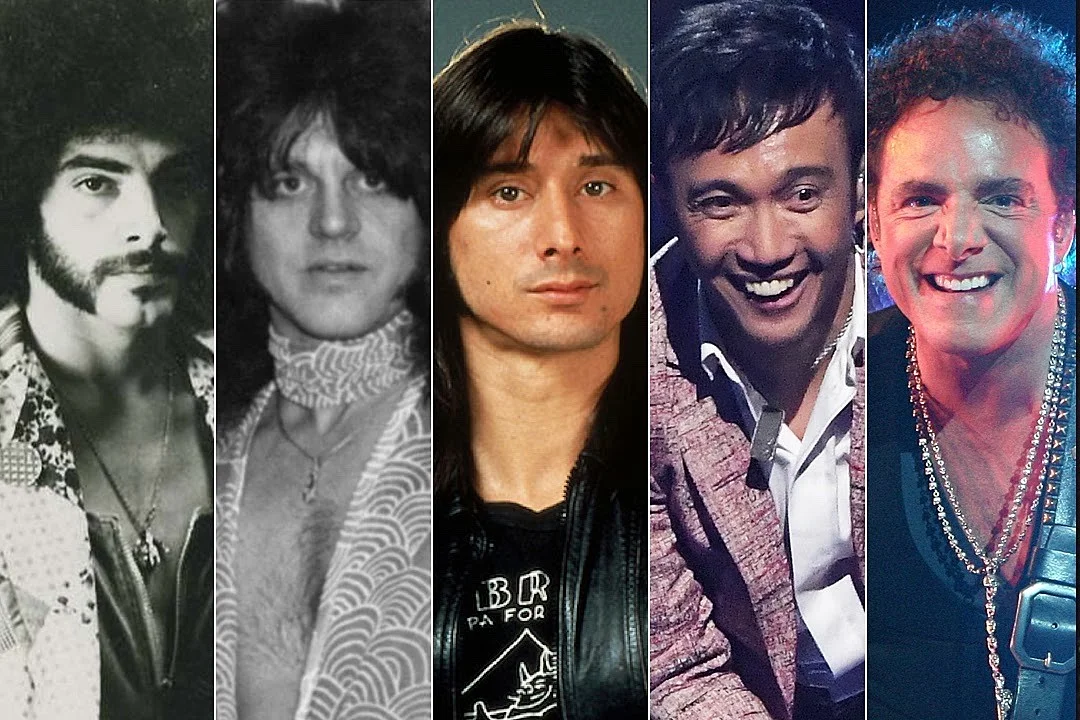
Journey Lead Singers In Order: History and Band Members
In this article, we delve into the captivating history of Journey, an iconic rock band that has left an indelible mark on the music industry. From their humble beginnings to their meteoric rise to fame, Journey has mesmerized audiences worldwide with their unique sound and timeless hits. Join us on a journey through time as we explore the remarkable story of this legendary band.
Formation of the Band
Journey was formed in 1973 in San Francisco, California, bringing together a group of highly talented musicians. The founding members included Neal Schon, Gregg Rolie, Ross Valory, Aynsley Dunbar, and George Tickner. With their combined musical prowess and creative vision, they set out to create something extraordinary.
Early Years and Musical Style
During their early years, Journey experimented with a fusion of rock, jazz, and progressive influences, creating a distinctive sound that set them apart from their contemporaries. Their self-titled debut album, released in 1975, showcased their musical versatility and marked the beginning of their incredible journey.
Evolution and Breakthrough Success
In 1977, Journey underwent a significant change that would forever shape its destiny. Steve Perry joined the band as their lead vocalist, injecting new energy and unparalleled vocal range into their music. This lineup change proved to be a turning point for Journey, leading to a series of chart-topping albums and unforgettable songs.
Chart-topping albums and Hit Singles
Journey’s breakthrough came in 1978 with the release of their album “Infinity,” which became a massive success. The album spawned the hit singles “Wheel in the Sky” and “Lights,” propelling Journey into the mainstream spotlight. They continued their winning streak with subsequent albums, including “Evolution” (1979) and “Departure” (1980), which produced hits like “Lovin’, Touchin’, Squeezin'” and “Any Way You Want It.”
The Iconic Album: “Escape”
In 1981, Journey released their most iconic album to date, “Escape.” This album elevated their status as rock superstars and solidified their place in music history. Featuring the mega-hits “Don’t Stop Believin’,” “Open Arms,” and “Who’s Crying Now,” “Escape” became an instant classic, captivating audiences with its emotionally charged lyrics and powerful melodies.
The Power Ballad Era
Journey’s success continued into the mid-1980s, defined by the rise of power ballads that struck a chord with fans worldwide. Songs like “Faithfully,” “Separate Ways (Worlds Apart),” and “Send Her My Love” showcased the band’s ability to create heartfelt and anthemic ballads that resonated deeply with listeners.
A Change in Direction
As the 1990s approached, Journey faced challenges and underwent significant lineup changes. Steve Perry departed from the band in 1987, leading to a period of transition as they searched for a new lead vocalist. Despite these challenges, Journey remained resilient and continued to produce music that captivated its loyal fan base.
Journey’s Enduring Legacy
Although the band’s popularity waned in the late 1990s, their music never faded from the hearts of their dedicated fans. Journey’s timeless classics continue to resonate with audiences of all ages, thanks to their emotional depth, infectious melodies, and inspiring lyrics. Their songs have become anthems for perseverance, love, and the power of music itself.
Past Journey band members include the following:
- Steve Perry (1977-1998)
- Aynsley Dunbar (1974-1978)
- Robert Fleischman (1977)
- Steve Smith (1978-1985, 1995-1998)
- Randy Jackson (1985-1987)
- Steve Augeri (1998-2006)
Current Journey band members:
- Neal Schon – Guitar (1973-present)
- Jonathan Cain – Keyboards (1980-present)
- Ross Valory – Bass (1973-1985, 1995-present)
- Arnel Pineda – Vocals (2007-present)
- Deen Castronovo – Drums (1998-present)
Lead Singers of Journey
Van Halen Lead Singers In Order: A Journey Through the Years
Black Sabbath Singers In Order: Ever-Changing Lineup of Black Sabbath
The Original Journey: Gregg Rolie’s Era
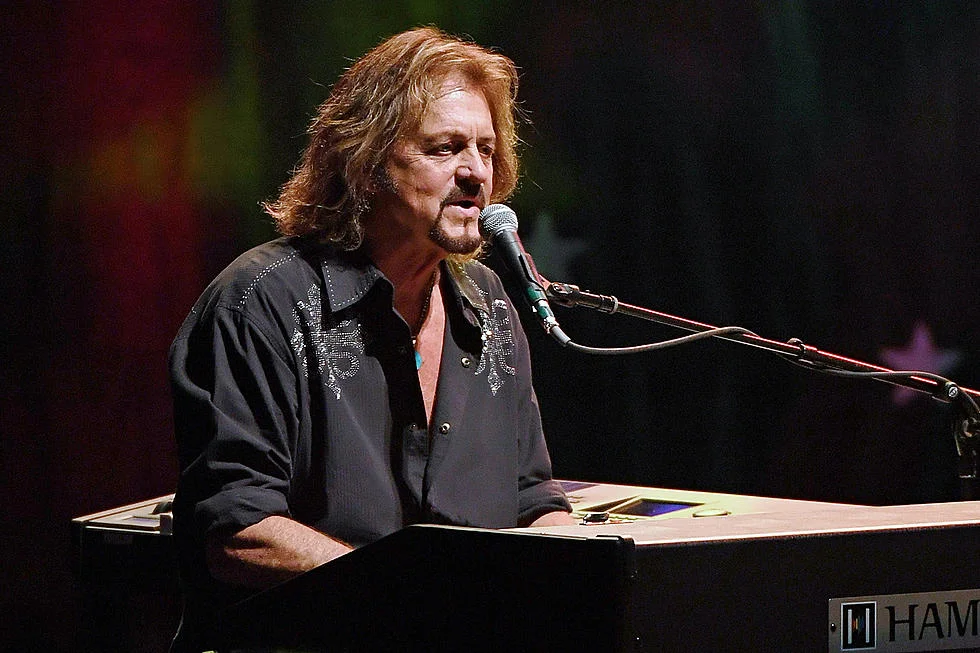
Gregg Rolie, a two-time Rock and Roll Hall of Fame inductee, served as the original lead singer of Journey. He began his musical career as a co-founder and lead vocalist of Santana before joining forces with Neal Schon to form Journey. Rolie’s soulful voice and exceptional skills as a keyboardist and harmonicist contributed to the band’s early success. He showcased his talent on albums like “Journey,” “Look into the Future,” and “Next.” However, Rolie transitioned to co-lead vocals when Steve Perry joined the band in 1977.
Steve Perry: The Voice of Journey’s Greatest Hits
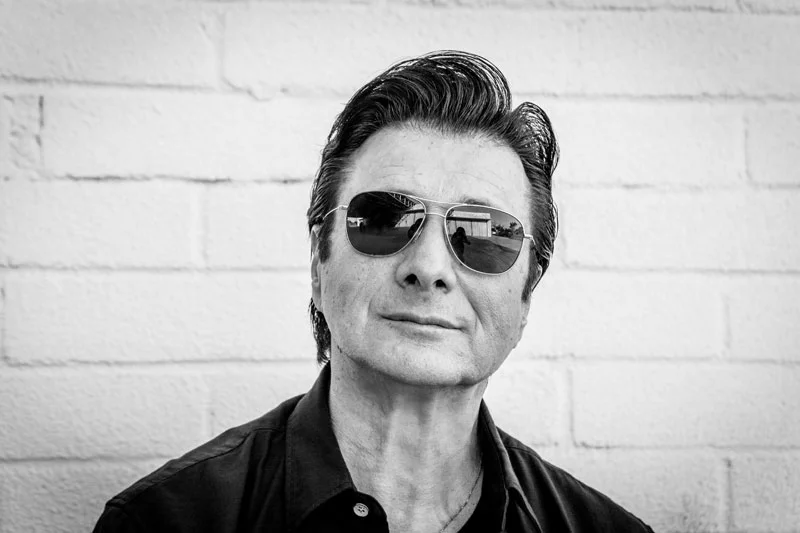
Steve Perry, widely recognized as the quintessential Journey lead singer, propelled the band to unprecedented heights during their most commercially successful era. Born with a gift for singing, Perry’s powerful and emotive vocals struck a chord with audiences worldwide. With Perry at the helm, Journey released a string of chart-topping albums, including “Infinity,” “Escape,” and “Frontiers.” Iconic songs like “Don’t Stop Believin’,” “Open Arms,” and “Faithfully” became anthems for a generation. Perry’s remarkable songwriting abilities and magnetic stage presence contributed to the band’s enduring legacy.
Current Lead Singer: Arnel Pineda

Following Steve Perry’s departure in 1987, Journey experienced a series of lead singer changes. Steve Augeri, known for his vocal range and stage charisma, took over from 1998 to 2006. Jeff Scott Soto briefly joined the band in 2006, leaving his mark with his distinctive style. However, it was Arnel Pineda who breathed new life into Journey as the current lead singer. Pineda’s incredible vocal resemblance to Steve Perry, coupled with his dynamic stage presence, won the hearts of fans worldwide. Since 2008, Pineda has seamlessly integrated into the band, injecting fresh energy and passion into their performances.
Journey’s Enduring Discography: Albums That Defined an Era
Over the past five decades, Journey has released a diverse and extensive discography, showcasing their musical prowess and creativity. Let’s explore some of their most iconic albums:
“ Infinity ” (1978): With Steve Perry as the lead singer, “Infinity” marked a significant turning point for Journey. It featured hit singles like “Wheel in the Sky” and “Lights,” solidifying their place in the rock music landscape.
“ Escape ” (1981): This album became a monumental success, boasting chart-topping hits such as “Don’t Stop Believin'” and “Open Arms.” “Escape” catapulted Journey to international stardom and remains one of their most beloved records.
“ Frontiers ” (1983): Building upon their previous success, “Frontiers” showcased Journey’s evolution with tracks like “Separate Ways (Worlds Apart)” and “Faithfully.” The album’s polished production and memorable hooks solidified Journey’s status as one of the biggest rock bands of the 1980s.
“ Raised on Radio ” (1986): Released during the band’s final years with Steve Perry, “Raised on Radio” featured a more radio-friendly sound and produced hits like “Be Good to Yourself” and “I’ll Be Alright Without You.” Despite tensions within the band, the album showcased their ability to create catchy, melodic rock tunes.
“ Revelation ” (2008): With Arnel Pineda as the lead singer, “Revelation” marked a new chapter for Journey. The album featured new recordings of their classic hits, reaffirming Pineda’s vocal prowess and rekindling the band’s popularity among longtime fans and a new generation.
“ Eclipse ” (2011): Continuing their musical journey with Pineda, Journey released “Eclipse,” a record that showcased their ability to evolve while staying true to their roots. The album demonstrated their enduring songwriting skills and featured tracks like “City of Hope” and “Edge of the Moment.”
“Escape & Frontiers Live in Japan” (2019): As a testament to their enduring appeal, Journey released a live album featuring their performances of the “Escape” and “Frontiers” albums in their entirety. The release showcased the band’s timeless hits in a live setting, capturing the energy and excitement of their concerts.
Journey’s Impact and Legacy
Journey’s impact on the rock music landscape cannot be overstated. With their infectious melodies, anthemic choruses, and powerful vocals, they carved out a unique sound that resonated with millions of listeners. Their music transcended generations, becoming the soundtrack to countless moments and capturing the hearts of fans worldwide.
Steve Perry’s tenure as the lead singer marked the band’s most successful period, and his distinct voice became synonymous with Journey’s sound. His emotional delivery and ability to connect with audiences elevated their songs to new heights and created an unparalleled legacy.
Arnel Pineda’s addition to the band injected new energy into Journey and allowed them to continue their musical journey. Pineda’s remarkable vocal resemblance to Perry breathed new life into the band’s live performances, earning him a dedicated fanbase and ensuring that Journey’s music lives on.
Journey’s timeless hits continue to be celebrated and embraced today. Songs like “Don’t Stop Believin'” have become cultural touchstones, appearing in films, TV shows, and sporting events, and capturing the imaginations of new generations of listeners.
Journey Band Member’s Ages
Here, is the list of all the Journey member’s ages. It seems like all of the Journey band members are above 50 and below 80.
Leave a Comment Cancel reply
Save my name, email, and website in this browser for the next time I comment.
Journey complete – Whitman drummer Steve Smith in Rock Hall of Fame

The arena-rock band Journey , featuring Whitman drummer Steve Smith , was inducted into the Rock and Roll Hall of Fame this weekend at the Barclays Center in Brooklyn, N.Y.
Smith played drums for Journey from 1978 to 1985, the years the band had its biggest hits. He was the drummer when the group’s signature song “Don’t Stop Believin’” was recorded in 1981.
“I started out in 1963 at 9 years old as a jazz drummer,” Smith said during his heartfelt induction speech Friday night. “I thank my parents for ... supporting my musical passion.”
Smith, 62, got his start as a drummer in the fourth grade, taking lessons at a small drum shop in Brockton. Smith graduated Whitman-Hanson Regional High School in 1972.
In his speech Smith also related how he discovered rock ’n’ roll through Jimi Hendrix, Cream and Led Zeppelin. “But what I heard was Mitch Mitchell, Ginger Baker and John Bonham,” he said. “I could relate to rock drumming and rock music.”
Need a break? Play the USA TODAY Daily Crossword Puzzle.
He attended Berklee College of Music in Boston and played in a jazz band with violinist Jean-Luc Ponty and guitarist Ronnie Montrose. In 1978, they performed as an opening act for Journey on a three-month concert tour. Later that year Smith replaced Aynsley Dunbar in the Journey lineup. “... and it’s been an educational award in the process,” Smith said. He also thanked his wife, Diane and children Ian and Elizabeth.
In addition to touring with Journey, Smith has played with Mariah Carey, Bryan Adams, Savage Garden and Phil Collins. He has also played drums for a number of jazz groups, including Steve Smith’s Jazz Legacy and Vital Information.
In 2002, Smith was voted into the Modern Drummers Hall of Fame.
Smith wrapped up his induction speech with a nod to Journey’s supporters. “Thanks to our fans from around the world who kept Journey in their hearts and on their stereos.”
With Smith on drums, Journey performed three of their biggest hits during the induction ceremony – “Separate Ways,” “Lights,” and “Don’t Stop Believin’.” Former Journey frontman Steve Perry appeared alongside his ex-bandmates during ceremony, but he did not perform.
Smith rejoined Journey for another trip last year year. They will perform two concerts in the area this summer – June 16 at the Mohegan Sun Arena and June 19 at the DCU Center in Worcester.
Smith lives in Manhattan and also Oregon, but still maintains ties to the South Shore. Last year he donated signed CDs, books, drum heads and sticks to the Whitman Cultural Council as part of an online fundraiser to benefit the organization that supports art in the community.
“I have a connection to that and wanted to support the cause,” Smith told the Brockton Enterprise last December.
His parents – dad Bruce Smith spent four decades at the Brockton Enterprise, including as managing editor – still live in the area, now retired in Chatham.
HBO will air an edited version of the ceremony at 8 p.m. on April 29. Other inductees were the Electric Light Orchestra, Pearl Jam, Joan Baez, Tupac Shakur and Yes.
Inductees will eventually be enshrined in the Rock and Roll Hall of Fame museum in Cleveland.
Dana Barbuto may be reached at [email protected] or follow her on Twitter @dbarbuto_Ledger.
- Updated Terms of Use
- New Privacy Policy
- Your Privacy Choices
- Closed Caption Policy
- Accessibility Statement
This material may not be published, broadcast, rewritten, or redistributed. ©2024 FOX News Network, LLC. All rights reserved. Quotes displayed in real-time or delayed by at least 15 minutes. Market data provided by Factset . Powered and implemented by FactSet Digital Solutions . Legal Statement . Mutual Fund and ETF data provided by Refinitiv Lipper .
Journey celebrates 50th anniversary: Rock band members then and now
Journey was formed in february 1973 by neal schon, gregg rolie and herbie herbert.
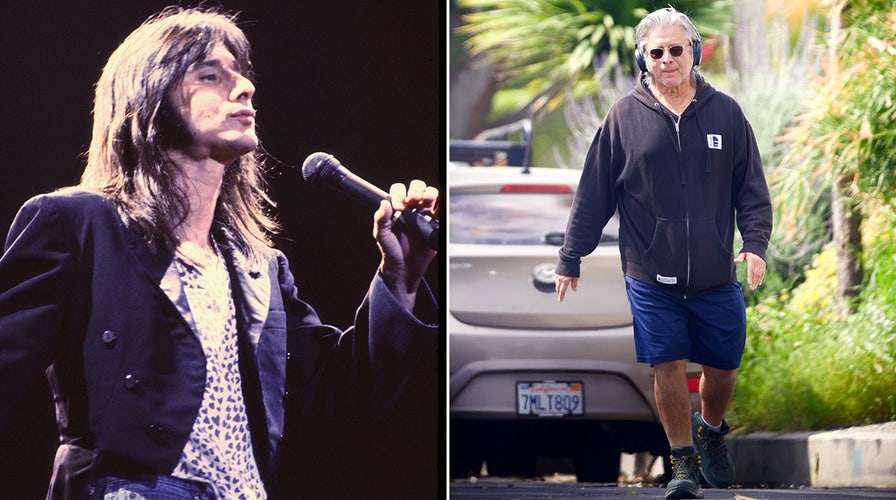
Fox News Flash top entertainment headlines of the week
Fox News Flash top entertainment and celebrity headlines are here.
Journey recently celebrated 50 years since the band first formed.
The band's most well-remembered lead singer, Steve Perry, was spotted on a walk in Los Angeles earlier this month. The 74-year-old was the frontman and prominent songwriter for the band for 10 years alongside Neal Schon, Gregg Rolie, Ross Valory, Jonathan Cain, Aynsley Dunbar and Steve Smith.
Current members of the band include Schon, Cain, Deen Castronovo, Arnel Pineda, Jason Derlatka and Todd Jensen.
Here is what Journey band members from the Perry era are up to now as the band's 50th anniversary tour comes to a close April 25 in Palm Springs, California.
STEVE PERRY WOWS CROWD AFTER 19 YEAR ABSENCE FROM STAGE
Steve Perry

Steve Perry was brought on as a replacement for lead singer Robert Fleischman and was the frontman during the band's most prosperous era. (Shutterstock/SplashNews.com)
Steve Perry joined the band as a replacement for Robert Fleischman, making his debut as the frontman in October 1977. As well as acting as the band's lead singer, Perry also was one of the band's principal songwriters. He was nominated to the Songwriter's Hall of Fame in 2020.
Although fans were skeptical of Perry when he first joined the band, he was able to win fans over after the release of his first album, "Infinity," which had a much different sound than Journey had created in the past. They then began getting more radio airplay. He sang lead vocals on the albums "Evolution," "Departure," "Dream, After Dream," "Captured," "Escape," "Frontiers," "Raised on Radio" and "Trial By Fire."
Perry went solo for the first time in 1984 when he released "Street Talk," which sold over 2 million copies and featured the singles "Oh Sherrie" and "Foolish Heart." He was also featured on the 1985 benefit song, "We Are the World." He attempted to reunite with Journey. However, he was caring for his ill mother and couldn't be present for a majority of recording, and the band went on break in 1987 after its "Raised on Radio" tour.
In 1988, Perry began working on a second solo album, which he never released, eventually releasing a successful second album in 1994, called "For the Love of Strange Medicine."
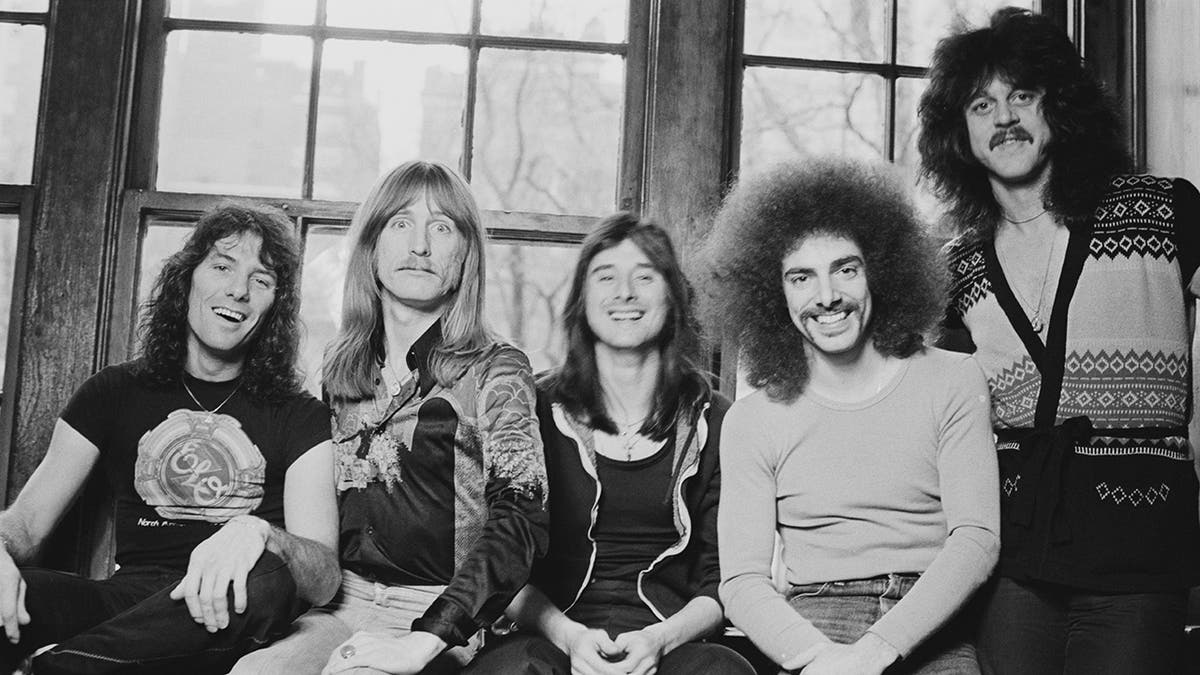
Perry sang lead vocals on the albums, "Evolution," "Departure," "Dream, After Dream," "Captured," "Escape," "Frontiers," "Raised on Radio" and "Trial By Fire." (Michael Putland/Getty Images)
The singer once again reunited with his former band in 1996 to record the very successful album, "Trial By Fire," which debuted at No. 3 on the Billboard charts and went platinum by the time the year was over. To capitalize on the success of the album, a tour was planned, but it had to be postponed due to Perry injuring his hip while hiking in Hawaii.
A doctor determined his injury required surgery, but Perry was reluctant to agree to go under the knife. The decision delayed the tour longer than expected, which angered his bandmates. They eventually went on tour without Perry, and he announced his permanent exit from the band.
"I had to have a hip replacement, and the band was telling me when they thought I should do it," Perry said in an interview with MelodicRock.com in 2011. "And I said, ‘Major surgery like this is not a band decision.' I said that I would get it done, but I didn't get it done quickly enough. They just wanted to get on the road, and there was an ultimatum given to me. And I don't respond well to ultimatums."
FORMER JOURNEY FRONTMAN STEVE PERRY REVEALS WHY HE LEFT BAND AT ITS HEIGHT
Following his departure from the band, he released his "Greatest Hits + Five Unreleased" compilation album, which featured songs from his 1988 unreleased album. In 2005, Perry joined a few of his former bandmates when Journey was awarded a star on the Hollywood Walk of Fame. In 2009, he was voted one of the ten greatest rock singers of all time, and Rolling Stone placed him at number 76 in a list of "The 100 Greatest Singers of All Time."
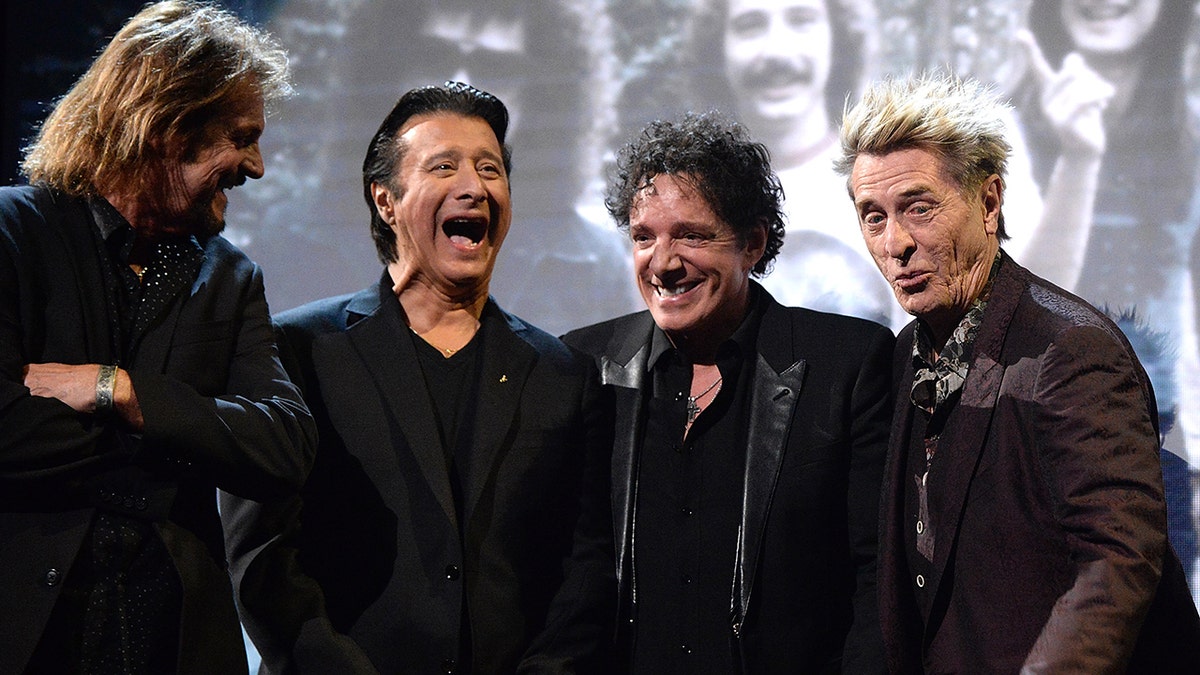
Perry joined his former bandmates on stage in 2017 for the band's induction into the Rock & Roll Hall of Fame. (Kevin Mazur/WireImage for Rock & Roll Hall of Fame)
For the next few years, Perry continued singing and writing, appearing on background vocals or on stage with various bands and artists. In 2017, he appeared on stage with Journey for the first time since they were together on the Walk of Fame in 2005 to accept the honor of being inducted into the Rock & Roll Hall of Fame. He did, however, opt out of performing with the band.
In 2018, Perry released another solo album, "Traces," which performed well, with a deluxe version debuting in 2019. In December 2021, he released a Christmas album, "The Season," and in 2023 he announced he would be singing background on Dolly Parton's new album.
Perry has a daughter and grandchildren but has chosen not to speak about them publicly to protect their privacy.

Neal Schon is a founding member and guitarist for the band Journey. (Getty Images)
Neal Schon is a founding member of Journey and is the longest-serving original member of the band. Prior to helping create Journey, he was a member of the band Santana, playing guitar on the albums "Santana III" and "Caravanserai."
He briefly played with the band Azteca before founding Journey with Gregg Rolie and their manager Herbie Herbert. They initially called the band the Golden Gate Rhythm Section, however the name was changed after their roadie John Villaneuva suggested Journey.
Along with playing on the albums "Journey," "Look into the Future," "Next," "Arrival," "Generations" and "Revelation with Journey," Schon also released several solo albums, including "Late Nite," "Beyond the Thunder," "Piranha Blues," "The Calling," "So U" and "Universe."
The guitarist also produced two albums with keyboardist Jan Hammer and was a member of the supergroup Bad English. He also has fostered collaborations with Sammy Hagar as part of Hagar Schon Aaronson Shrieve and Paul Rodgers. Schon also plays guitar on Michael Bolton's album, "The Hunger.
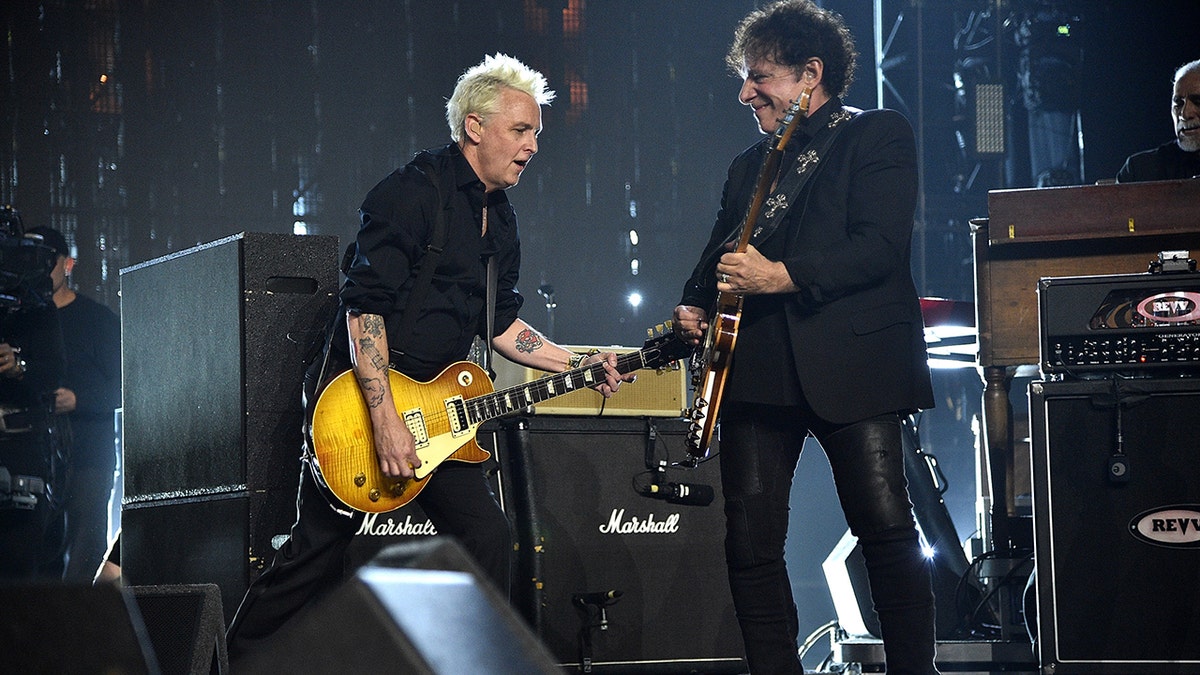
Schon performed with his band at the 2017 Rock & Roll Hall of Fame ceremony, where Journey was being honored. (Kevin Mazur/WireImage for Rock and Roll Hall of Fame)
In 2005, Schon was present at the Hollywood Walk of Fame ceremony to accept the honor of receiving a star alongside his fellow bandmates. They reunited again in 2017 when they were inducted into the Rock and Roll Hall of Fame, where he and some of the other band members performed.
Schon is performing with Journey for the band's 50th anniversary tour, which also features Toto.
JOURNEY'S NEAL SCHON SLAMS BANDMATES OVER TRUMP MEETING
In September 2011, Schon confirmed his romance with former "Real Housewives of D.C." star Michaele Salahi, while also revealing they dated briefly in the '90s. Just a little over a year later, in October 2012, Schon proposed to her on stage while performing at a charity benefit, and the two were married in December 2013.
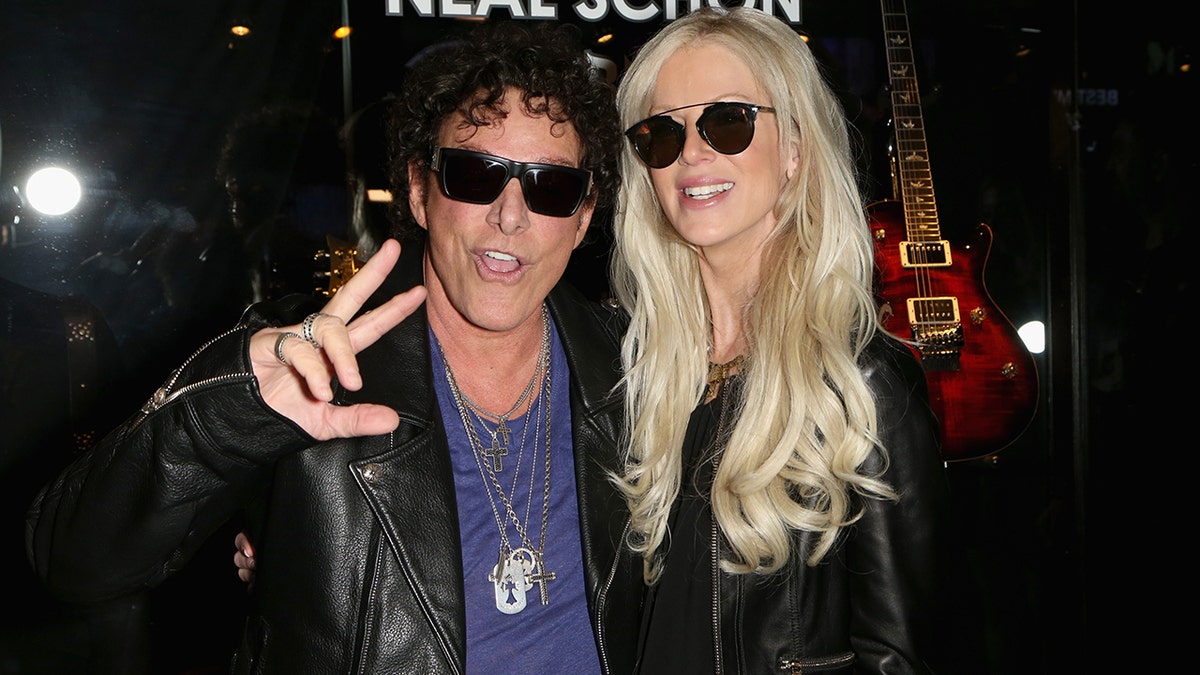
Schon is married to his fifth wife, Michaele Salahi, a former "Real Housewife of D.C." (Gabe Ginsberg/Getty Images)
Schon was previously married to Tena Austin from 1976 to 1986. He was then married to Beth Buckley from 1987 to 1992, and had two children with her, Miles and Elizabeth, before splitting up. He then married Dina Gioeli from 1993 to 1999, and then Amber Kozan (from 2001-2008), with whom he has two children, Aja and Sophia. He also has a daughter named Sarah.
Gregg Rolie
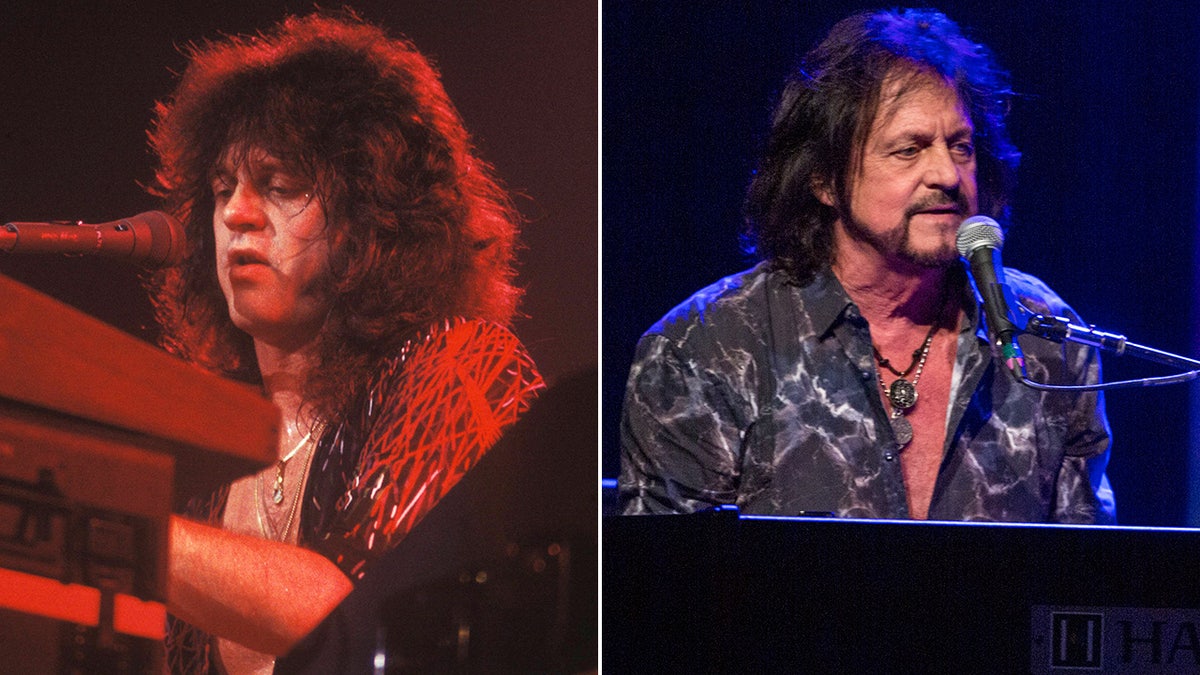
Gregg Rolie was a member of Santana before forming Journey and was the lead singer on the first two albums. (Getty Images)
Gregg Rolie was a founding member of Santana before branching off to join what would become Journey. For the band's first six albums, he was the keyboardist, and he was the lead vocalist for the band's first two albums. Once Perry joined the band, Rolie sang co-lead on a few songs on various albums.
The musician chose to leave the band in 1980 and started a successful solo career. His first solo album was "Gregg Rolie," and he followed up with "Gringo" in 1987.
"I left because I didn’t like my life anymore," Rolie told Rolling Stone in 2019. "I’ve said this a million times. And I know there’s people that say, ‘That’s not the reason.’ But I left because I was unhappy with what I was doing in my own life. I loved the management. I loved the music. I loved what we built. I just wasn’t happy, so I had to blow the horn on it and just stop it."
A few years after releasing his second album, Rolie formed another band with Steve Smith and Ross Valory from Journey in 1991 called The Storm. Rolie worked as the keyboardist for this band. The band's eponymous debut album was a huge success, reaching No. 3 on the Billboard charts. It also featured a top 10 hit, "I’ve Got A Lot To Learn About Love."
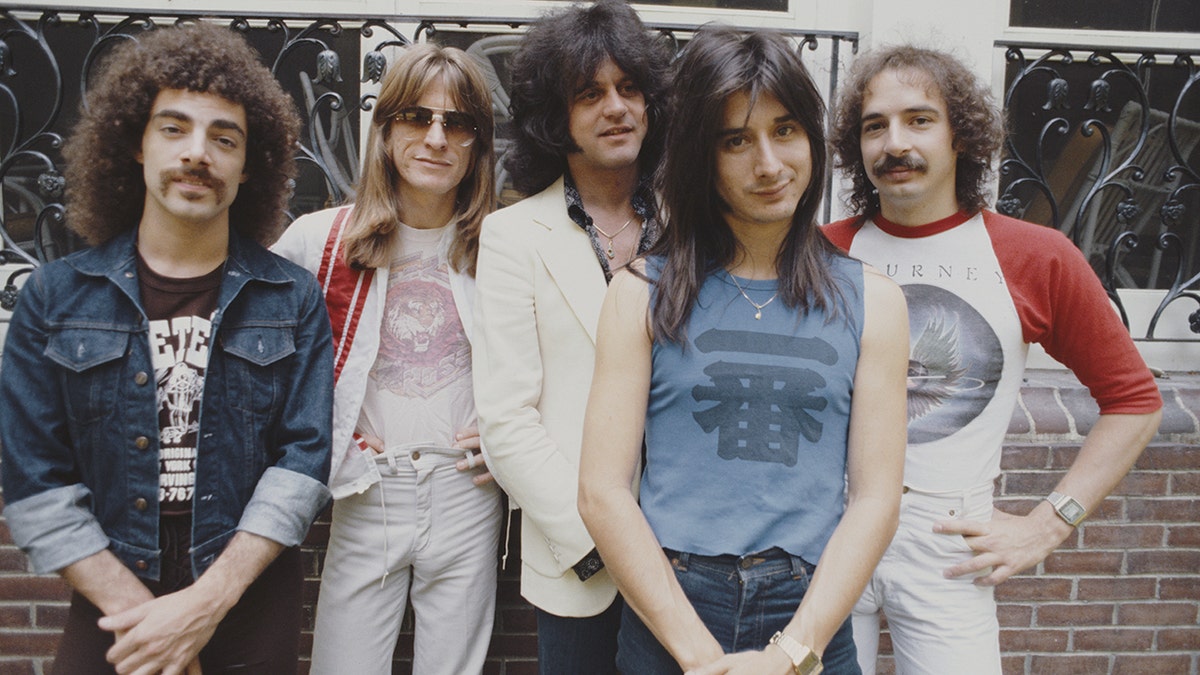
Rolie left Journey in 1980 and started a solo career before founding another band. (Getty Images)
They did not reach the same amount of success with their second album. It was shelved by their record company before finally getting released in 1996. In 1998, Rolie and a few other members of Santana reunited to form the band Abraxas Pool, ultimately releasing one eponymous album.
Also in 1998, Rolie was inducted, along with the other members of Santana, into the Rock & Roll Hall of Fame. He became a two-time Rock & Roll Hall of Fame inductee in 2017 with Journey.
In 1999, while working on an album with Ron Wikso, they formed The Gregg Rolie Band, which featured Kurt Griffey on the guitar and Wally Minko as a second keyboardist. Together, they released the album "Roots" and a live CD, "Rain Dance," in 2009.
From 2012 to 2021, Rolie toured as a member of Ringo Starr and his All Star Band, during which he sang many of the hits he is known for, including some from his time in Santana. While performing, he also recorded an album with original members of Santana in 2016, "Santana IV."

Rolie frequently appears on stage with Schon and the rest of Journey during their 50th anniversary tour. (Rob Loud/Getty Images for Journey)
Rolie reunited with Schon in 2018 to perform some charity shows and occasionally joined Journey on stage during its most recent tour.
The keyboardist married his wife Lori in 1980 after first meeting her while on a flight in 1979. The two have remained together and live in Texas. They have two children together, a son named Sean and a daughter named Ashley.
Ross Valory
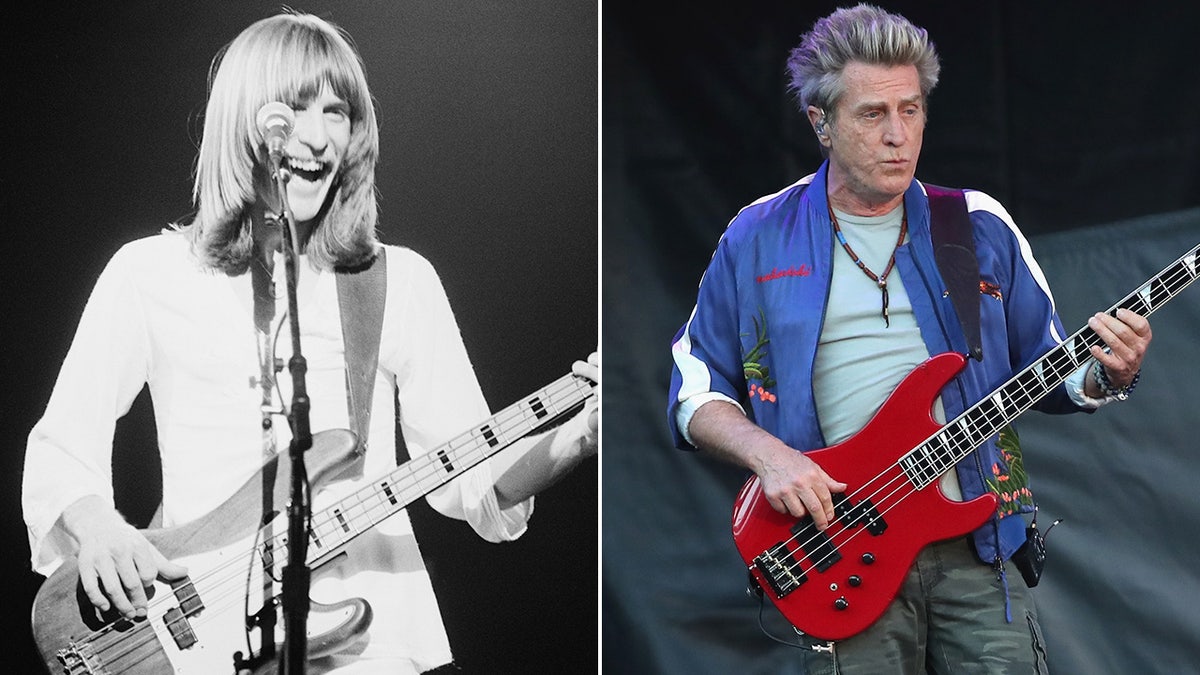
Ross Valory was an original member of Journey, which he joined after forming and releasing one album with the Steve Miller Band. (Getty Images)
Ross Valory was an original member of Journey, which he joined after forming and releasing one album with the Steve Miller Band. As a bassist, he has played on all the band's albums, except 1986's "Raised on Radio" and 2022's "Freedom."
During the band's hiatus in the late ‘80s and early ’90s, Valory played on Todd Rundgren's album, "2nd Wind," and released two albums as a member of The Storm, "The Storm," and "Eye of the Storm."
He returned to playing with Journey in 1996 on the "Trial by Fire" album. Valory was kicked out of the band in 2020, and he was once again replaced by Randy Jackson, who also took over for him in "Raised on Radio."
His 2020 exit came on the heels of a lawsuit involving him and Steve Smith, filed by their Journey bandmates Neal Schon and Jonathan Cain. Schon and Cain claimed Valory and Smith attempted to take over Nightmare Productions to gain control of the Journey trademark.
Journey's management announced the two parties came to a settlement, releasing a statement in April 2021.
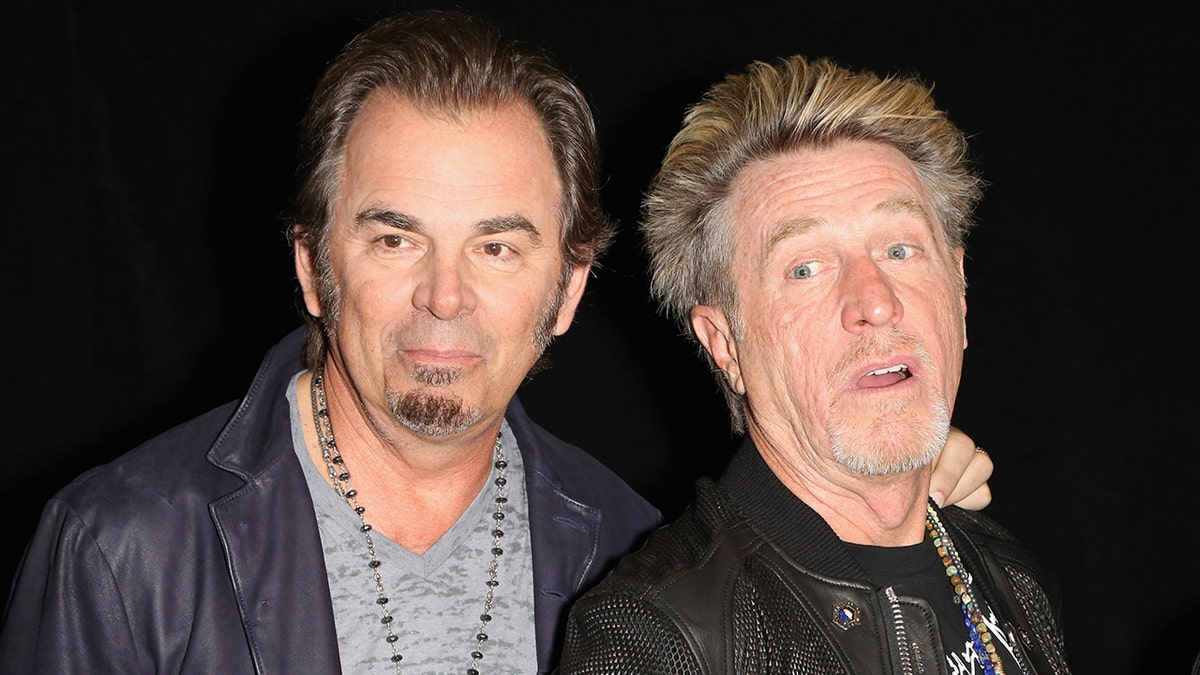
Ross Valory, right, was sued by his former bandmate, Jonathan Cain, left, for trying to gain control of the band's trademark. (Gabe Ginsberg/Getty Images)
"Neal Schon and Jonathan Cain acknowledge the valuable contributions that both Ross Valory and Steve Smith have made to the music and the legacy of Journey," the statement said. "Ross Valory and Steve Smith wish their former bandmates well and much success in the future. Journey looks forward to continuing to tour and make new music for their dedicated fans around the world."
Valory was once married to Diane Oakes, however the marriage ended in a divorced. He later married his current wife, Mary Valory.
Steve Smith
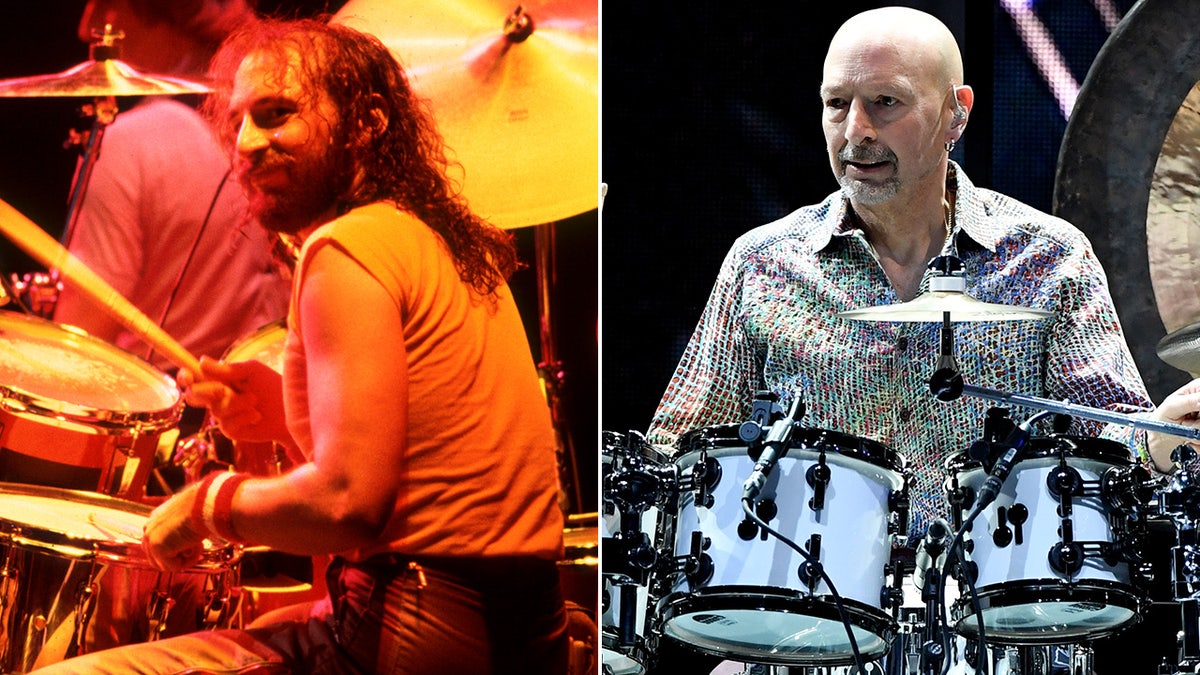
Steve Smith replaced Aynsley Dunbar as the drummer for Journey. (Getty Images)
Steve Smith replaced Aynsley Dubar as the drummer for Journey, joining the band in 1978 and staying on until 1985. His first album with the band was "Evolutions" in 1979, and he left for the first time following 1986's "Raised on the Radio."
During the band's hiatus, he joined Valory and Rolie in the band, The Storm, appearing on their two albums. He also started a second band, Vital Information, and released several albums with them in that time, including "Vital Information," "Orion," "Global Beat," "Fiafiaga" and "Easier Said Than Done."
He returned to Journey in 1995 for a comeback album, "Trial by Fire," staying on for a few years before leaving a second time after the release of 1998's "Greatest Hits Live" album. He continued to release music with Vital Information, including "Ray of Hope," "Where We Come From," "Live Around the World" and 2017's "Heart of the City."
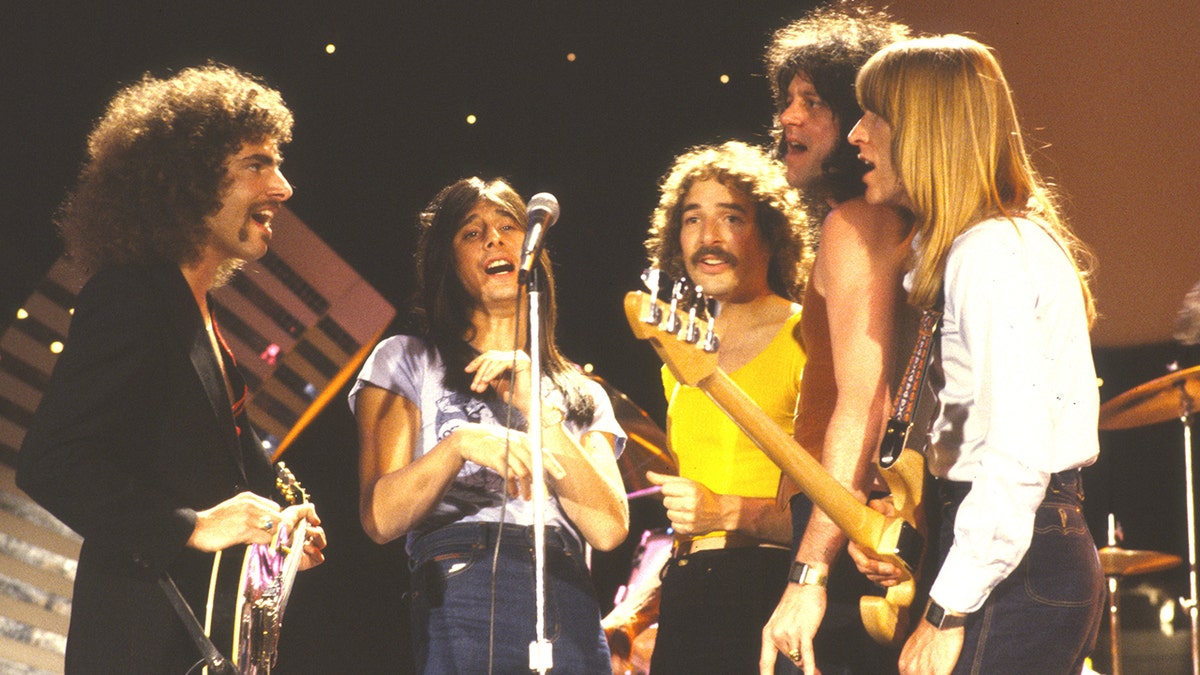
Smith left Journey and started his own band, Vital Information. (D Dipasupil/FilmMagic)
Smith was also a part of the jazz group Steps Ahead and can be heard playing on their albums "Live in Tokyo," "N.Y.C," "Yin-Yang" and "Steppin' Out." As a musician, he can also be heard on albums for Jeff Berlin, Frank Gambale, Henry Kaiser and Neal Schon.
In 2001, Modern Drummer magazine named Smith one of the Top 25 Drummers of All Time, and the following year he was inducted into the Modern Drummer Hall of Fame. Starting in 2007, he recorded two albums with Buddy's Buddies, a quintet made up of musicians who once played with Buddy Rich.
In 2017, Smith was inducted into the Rock & Roll Hall of Fame as a member of Journey. He performed with Journey during the ceremony.
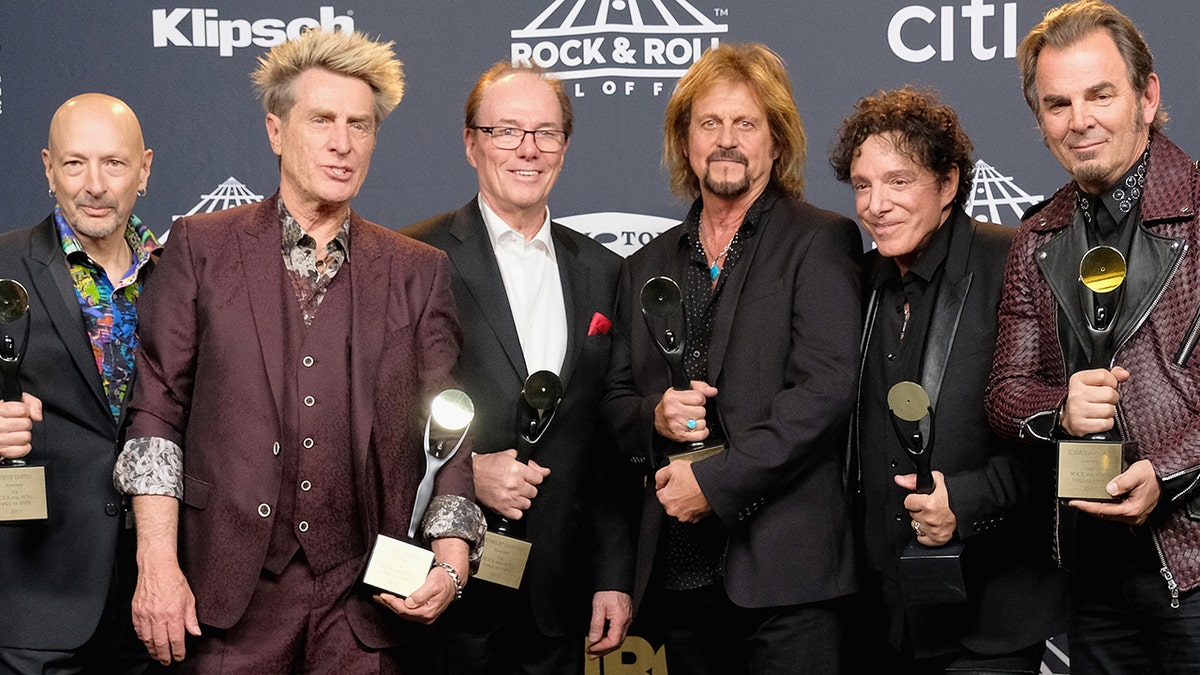
Smith was inducted into the Rock & Roll Hall of Fame alongside the other members of Journey. (D Dipasupil/FilmMagic)
Smith was also named in the lawsuit filed against him and Ross Valory when they allegedly tried to gain control of the Journey trademark. Like Valory, Smith was kicked out of the band at this time.
Jonathan Cain

Jonathan Cain was a member of The Babys before he left to join Journey, taking over the position Gregg Rolie held in the band. (Getty Images)
Jonathan Cain was a member of The Babys before he left to join Journey, taking over the position Gregg Rolie held in the band. Cain's first collaboration was on the album "Escape." He was also one of the composers of the band's longstanding hit, "Don't Stop Believin'."
JOURNEY'S JONATHAN CAIN RESPONDS TO CEASE-AND-DESIST ORDER, SAYS BANDMATE SHOULD 'LOOK IN THE MIRROR'
One of his most well-known contributions to the band was when he wrote the ballad "Faithfully," a song about what it's like to live life on the road. Cain went on to play the keyboard on the albums, "Frontiers," "Raised on Radio" and "Trial by Fire."
Prior to "Raised on Radio," Cain reunited with his former Babys bandmates and formed Bad English, releasing two albums before breaking up in the early 90s.
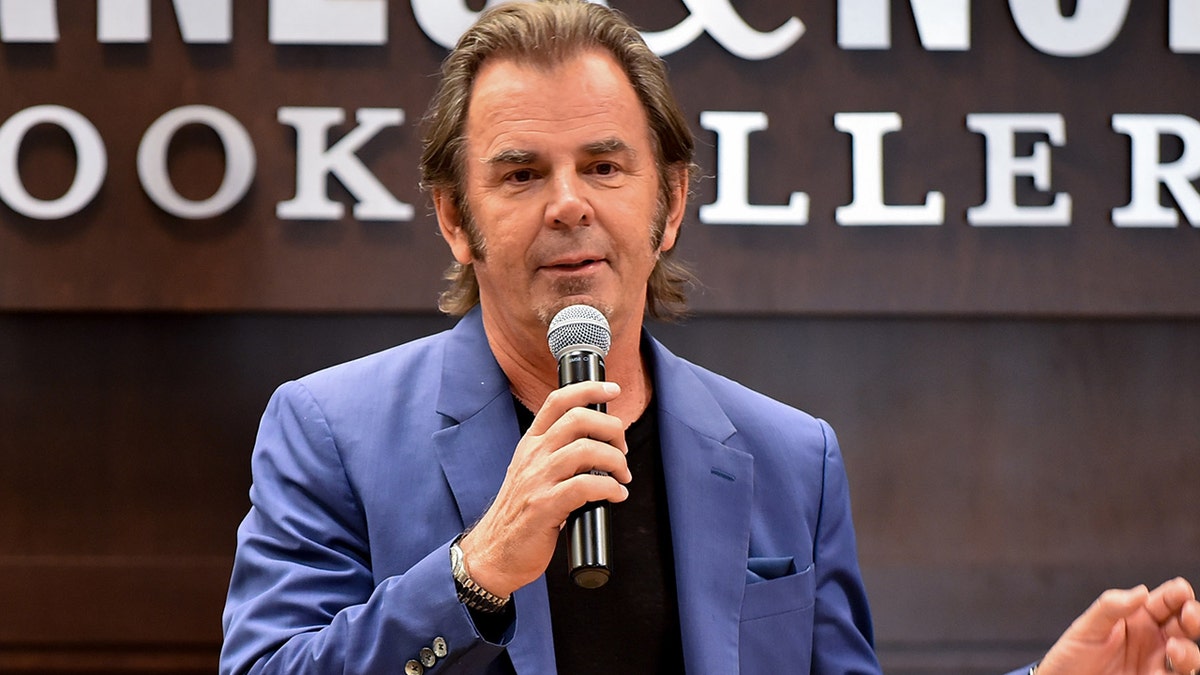
Cain wrote a memoir about his experience as a member of Journey in 2018, called "Don't Stop Believin': The Man, the Band, and the Song That Inspired Generations." (Brandon Williams/Getty Images)
Along with his albums with The Babys, Bad English and Journey, Cain recorded eight solo albums, including "Windy City Breakdown," "Back to Innocence," "What God Wants to Hear," "Bare Bones" and "More Like Jesus." He has primarily focused on making Christian-based faith music since 2016.
In 2018, Cain published a memoir, "Don't Stop Believin': The Man, the Band, and the Song That Inspired Generations," about his time as a member of Journey.
Cain married his first wife, singer Tane McClure, for which he wrote the song "Faithfully" before calling it quits.
In 1989, he married Elizabeth Yvette Fullerton, and together they had three children — a daughter Madison and twins Liza and Weston. The two divorced in 2014 after 25 years of marriage. In 2015, Cain married his third wife, a minister named Paula White.
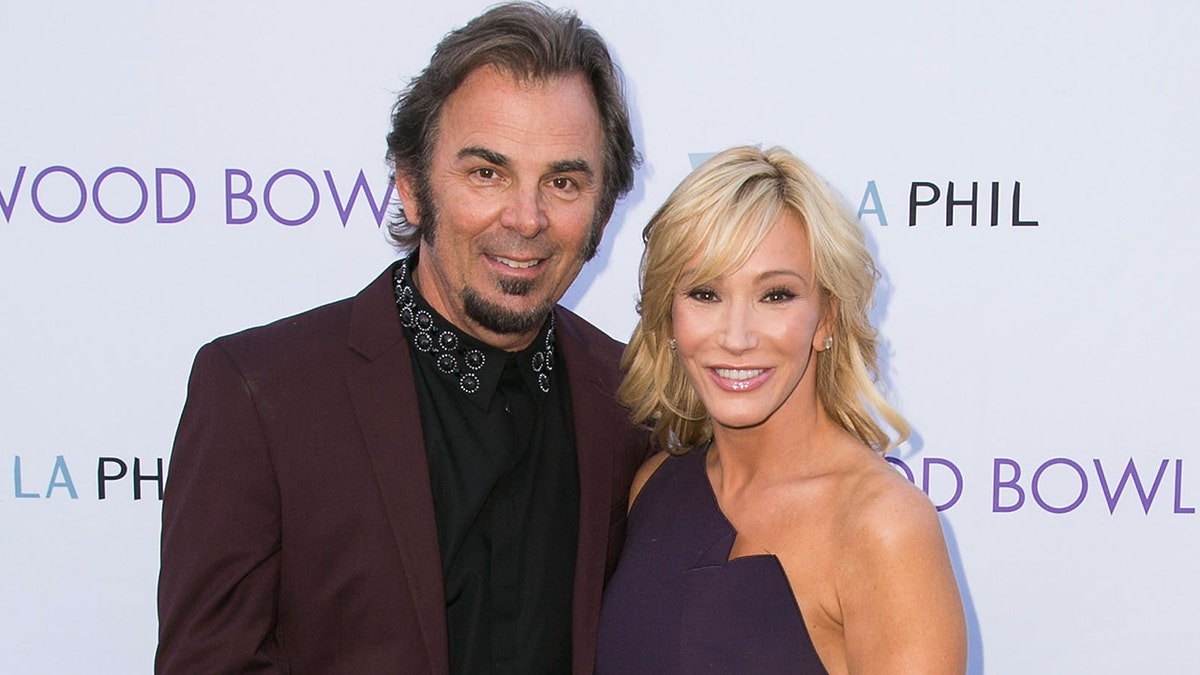
Jonathan married his third wife, Paula White, in 2015. (Vincent Sandoval/WireImage)
Cain and Schon are currently at odds and are in a legal battle over a shared American Express account.
Aynsley Dunbar

Aynsley Dunbar was the second drummer for Journey, taking over for Prairie Prince. (Getty Images)
Aynsley Dunbar was the second drummer for Journey, taking over for Prairie Prince, and played a big part in co-writing their first four albums, "Journey," "Look Into the Future," "Next" and "Infinity."
CLICK HERE TO SIGN UP FOR THE ENTERTAINMENT NEWSLETTER
Additionally, Dunbar played drums on albums for artists such as David Bowie, Lou Reed, Herbie Mann, Mick Ronson, Nils Lofgren, Ian Hunter, Sammy Hagar and Pat Travers.
Dunbar later joined Jefferson Starship and stayed with the band for three albums, including "Freedom at Point Zero," "Modern Times" and "Winds of Change." He then joined the band Whitesnake and stayed with them for two albums, including their eponymous record, which featured hits like "Still of the Night" and "What Is Love," and the album "1987 Versions."
Throughout the mid-90s, Dunbar played with some of the era's most notable bands and artists, including Aerosmith, Queen, Metallica, Black Sabbath, Pat Travers and Van Halen.
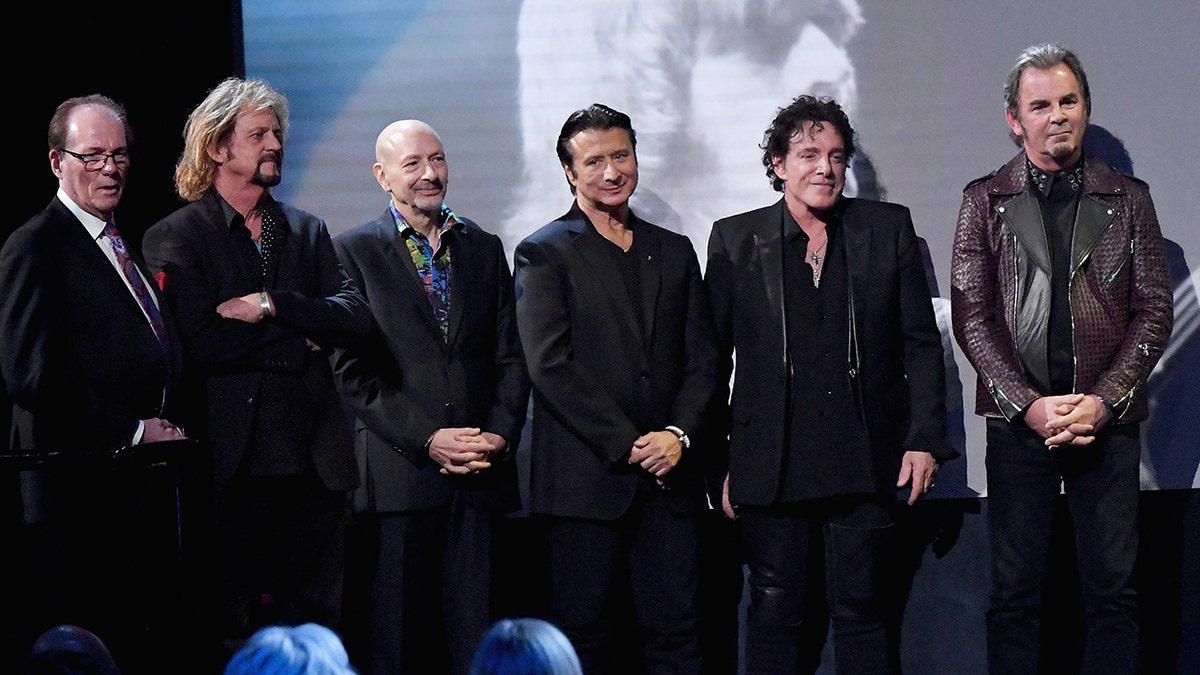
Dunbar was inducted into the Rock & Roll Hall of Fame in 2017, along with other members of Journey. (Mike Coppola/Getty Images)
CLICK HERE TO GET THE FOX NEWS APP
Aynsley has three children, Gretchen, Bibs and Taylor. In 2000, his 5-year-old son Dash died of brain cancer.
In 2005, Aynsley and the other members of Journey were honored with a star on the Hollywood Walk of Fame. In April 2017, Dunbar and the band were inducted into the Rock & Roll Hall of Fame for their contribution to the music industry.
Lori Bashian is an entertainment production assistant for Fox News Digital.

Eddie Murphy turned down drugs with Robin Williams and John Belushi: ‘God was looking over me’

Country singer Craig Morgan says young people don’t appreciate freedom of 'this great nation'

Dennis Quaid nearly rejected 'Reagan' role until one thing convinced him to do it

Robert Towne, Oscar-winning writer of ‘Chinatown,’ dies at 89

Bebe Rexha threatens to 'bring down' music industry, fears she will be ‘punished’ again

Pink ‘unable to continue’ with show, cancels day before concert on doctor’s orders

Who's making headlines in television, music, movies and more from Hollywood to the Heartland.
You've successfully subscribed to this newsletter!
earofnewt.com
Interviews with rock legends since 1982

That time drum great Steve Smith told me about getting kicked out of Journey by Steve Perry

By Steve Newton
Back in March of 1987 I interviewed American drummer Steve Smith , who was bringing his jazz-fusion group Vital Information to Vancouver for a club gig at the Town Pump.
Before that Smith had spent seven years with Journey, and was part of that band when it hit it big with singles like “Don’t Stop Believin’” and “Who’s Crying Now”, and multiplatinum albums like Evolution , Departure, and Escape .
But in late 1985 Smith suddenly left that lucrative position with Journey, so near the start of our conversation I asked him about that.
Have a listen:
To hear the full audio of my 1987 interview with Steve Smith subscribe to my Patreon page, where you can eavesdrop on over 400 of my uncut, one-on-one conversations with:
….with hundreds more to come
Share this:
Leave a reply cancel reply, discover more from earofnewt.com.
Subscribe now to keep reading and get access to the full archive.
Type your email…
Continue reading
Journey Frontman Arnel Pineda on the Band’s New Record, Dreams of a Steve Perry Reunion
By Andy Greene
Andy Greene
In early 2020, Journey frontman Arnel Pineda flew back to his native Manila after playing a corporate gig in Texas. He was gearing up for a big year in which Journey would cut their first new record since 2011’s Eclipse and play amphitheaters all over North America with the Pretenders.
The pandemic changed all that and he’s been in Manila ever since, but Journey still found a way to work remotely on the record. It’s their first full-length since parting ways with drummer Steve Smith and bassist Ross Valory. They were replaced by bassist Randy Jackson (who briefly toured and recorded with Journey in 1986–87) and drummer Narada Michael Walden, who’s doubling as the album’s producer.
We checked in with Pineda via Zoom to talk about his lockdown life in Manila, the in-progress Journey record, the upcoming biopic about his life, and why he still dreams about a Journey reunion with Steve Perry.
How are things going? Good. I arrived here in Manila last year just a week and a half before the lockdown began. I was lucky. Otherwise, I would have been stuck in America for six months before they let me back.
This must be the longest stretch of time you’ve been home since you joined Journey in 2007. Yeah. This is the longest. I like it because I got to spend a lot of time with family and the kids and more time with myself and my wife. There are other things I would rather do than tour, so I got the chance to be here. In a negative way, it’s quite bad. The survival here is a day-to-day deal. I’m the one that goes out a lot. I’m the one that goes to the market and the grocery to refill our food stocks.
You wonder if you have the virus every day. There’s a lot of paranoia going around. It’s like what is happening in America.
Do you miss playing live? Yeah. I especially miss the energy and the adrenaline of doing it. I’m delivering on the legacy that the Voice [Steve Perry] has left behind. Especially now that he formally passed the torch to me in 2017 [at the Rock and Roll Hall of Fame induction], he made that known and he was very gracious. It was very kind of him. It was so generous of him to say that in public. It was really an honor.
What was it like to finally meet Steve after all these years? I posted on Instagram that I had waited 35 years for that. It was dreamy. I couldn’t believe I met him since he’s very reclusive and he avoids people. He didn’t want to get interviewed, at least until he released his new record [ Traces ] and then suddenly he was out there, going to radio stations and accepting interviews.
Editor’s picks
Every awful thing trump has promised to do in a second term, the 250 greatest guitarists of all time, the 500 greatest albums of all time, the 50 worst decisions in movie history.
I was really surprised that he agreed to meet me. It’s one of the most special things that happened in my life. He’s one of my heroes when it comes to singing. I remember back in the Eighties, I would sleep on the bus with my Walkman on in my ears as his voice sang all these favorite songs from Journey.
I really dug his new record. It was amazing. I’ve been teasing Jonathan [Cain] and Neal [Schon]. “Why don’t you invite Steve Perry over for a tour?” Oh, my God. I never saw them back in the Eighties. I was just a young kid in Manila, just playing around, with no chance of going to the States and seeing their show, but they were one of my favorite bands.
I’ve spoken to Steve a bunch of times in the past few years. We even talked just a few weeks ago. Oh, my God!
Judging by our talks, I’m extremely confident that he’s happy to leave the Journey baton with you. That’s even more pressure I’m getting, hearing this from you. At the same time, I’m truly honored. But I’m not losing [the hope] that one day he’ll join the band for two or three songs. It would be one of the highlights of my life if that happens.
It would almost be on the scale of Led Zeppelin or Pink Floyd re-forming at this point. My God. It would be the same thing for me with Led Zeppelin because I haven’t seen them either, or Pink Floyd. I wish they would be complete again. It’s like completing a circle, being back up onstage again.
Do you think this long break has been good for your singing voice? Has it given you time to rest the muscle? I think so. At the same time, I can’t help but sing four or five songs here every day. The problem with the voice is that it changes as you grow older. It’s like athletes. They reach their peak on their 30th birthday. As they approach 31 or 32, it starts to change. It’s the same with my voice. I just want to make sure I can be of use to the band until they decide to throw the towel in.
Those are hard songs to sing for any singer. You guys go out and do 60 straight concerts in the summer and you need to hit the high notes on “Faithfully” every single time. That would be hard for anyone at any age. We’ll do five or six shows a week. I’m just quite amazed with myself a little. Somehow I was able to take it for 13 years. Let’s see what’s going to happen in the coming days. We’re on to finishing the album. We finished six songs so far. There’s talk of going out somewhere first, maybe Las Vegas for a residency. We don’t know yet. We haven’t decided. Just to break the ice between the new members and us.
You have six songs totally done? Yeah. And maybe seven songs to go.
Steve Perry Signs to New Label, Contemplates Solo Tour: 'I Miss It Terribly'
Hear the journey tune steve perry rerecorded with steve lukather's son.
Are these ballads? Rockers? For now, we’re doing the rocker songs first, not the ballads. I think the seven songs they’re working on, they’re working on something huge, like how you’ve known Journey doing ballads. It’s between [1981’s ] “Mother, Father” and [1978’s] “Winds of March.” We’re working on that song. We’ll see what happens. I’m waiting for them to send me the demos so that we can record it next week.
Working remotely like this must have been an adjustment. Normally, you’d be in the room together. I know. It’s quite hard right now. I have a few melody ideas that I’m into and want to share with them, but you can’t right now because of what is happening. I just have to listen to it and learn it. We use Zoom to record and I turn on my laptop and go into Logic Pro. They get ahold of it. If there’s something I want to change, I tell them. But it’s all pretty much done and I just record with them.
Are you doing the vocals on your laptop? Yeah. I’ll show you [ turns camera around and shows a microphone plugged into a computer in front of soundproofing foam ]. I share my computer, like mirroring. They can see what’s happening in my laptop. It allows them to hack it for a moment and then they can hear it. It happens in real time.
There’s no lag. I can hear that right now while we talk. It’s like you’re in the next room and you’re actually more than 8,000 miles away. Yeah. Thank God for the technology.
Do you think the album will come out this year? I think so. Neal thinks so. He can’t wait to release it before we do a full-on tour.
How do things sound different now that Randy Jackson and Narada Michael Walden are in the band? It’s somewhat like the sound back in the Eighties when Randy Jackson joined the band for the Raised on Radio album. It’s kind of like that, but it’s also more updated. Narada is producing my vocals and mentoring me on how to do it. He’s telling me to sing it this way and that way. It’s amazing. I’m learning a lot from Narada. It’s truly an honor and I appreciate him for doing so. It’s amazing.
Has the band even been in the same room yet? Have you met Randy and Narada in person? Right now, it’s just been virtual. It’s tough. I wanted to do it. I keep telling Neal, “If only I had been there, we would have done this in two months. Sorry it’s taking so long.” But with all these health protocols where you need to quarantine for two weeks, and then I come back and I’d be quarantined for another two weeks before I can join my family. It’s too much of a hassle, so we decided to do it this way even though Neal isn’t too happy about it. He wants it the old, classic way of making an album.
Moving on here, what’s the status of the movie about your life? It’s going to happen. I think they’re gonna start. Some people from Warner will start coming here. I think maybe with [ Crazy Rich Asians director] Jon Chu and [ Joker and The Fighter screenwriter] Scott Silver. They might come here to audition actors and actresses that will take part in my biopic.
Are you going to take them around town and show them the places you grew up? Yes. That’s the deal, of course. I want to show them where I grew up, where I was born, where everything happened before this whole magical thing.
Do you think the story will start in your childhood and show all your early bands and struggles and focus on the pre-Journey period? I think so, yeah. That’s the plan. I’ve spoken many times with Scott Silver. What’s interesting about my story is that I’ve survived two coup attempts here in the Philippines before I went to Hong Kong for 10 years. I don’t know he if plans to tell what happened to me in Hong Kong, but I had 10 years there. He might focus on my love story with my wife now.
I can see the grand finale in my head. It’ll be you walking onstage in Chile at your first Journey show. You’re nervous and they push you out and you burst into “Separate Ways.” Yeah. I was trying to back out five minutes before. I was like, “Neal, I cannot do this. This is not built for me.” They were like, “No. It’s too late. Get out there and do it.”
It was the turning point of your life. Everything is either before that moment or after that moment. You should tell Scott Silver about this idea. I’ve been implying it to him that we should end everything in Chile. And I remember when my wife decided to join me on tour in 2011. We were playing to a 30,000 crowd that night. I was telling my wife, “Remember Hard Rock Cafe when there were only three tables? Now it’s 30,000 people.” It was just unbelievable. It doesn’t get old to me. It’s still so surreal and bizarre.
I saw you at Citi Field with Fleetwood Mac and Madison Square Garden with Def Leppard. I could tell you were still having a blast. It’s still unbelievable. I’m just so blessed. I can’t thank them enough, especially Neal Schon. He was the one that was really sold that I am the one since 2007. But then again, I still think, “If only they could bring back Steve Perry.” You know what I mean?
I do, but if he came back, that would mean … I know, but I miss them so much together. Every now and then, I watch their videos together. It’s always them with Steve Perry that I watch. I mean, no offense to Adam Lambert. He’s an amazing performer and he has an amazing voice, but I still watch the old [Queen] ones with Freddie Mercury. That’s why when people say things like “No Perry, No Journey,” I understand it. Where I come from, we’re so influenced by Western music. We loved the originals, if you know what I mean.
His return would put you out of a job. That would be OK to me! I’m telling you. That’s how much I adore him and I adore Journey and how much I adore Steve Perry. Back in 2005, I resigned from my job in Hong Kong because I lost my voice due to acid reflux. I was telling my friends back then that my only regret was I lost my voice before I had the chance to sing side-by-side with Steve Perry. I was joking with them, but then a different situation happened. I just wish that one show with him … it would change my life forever. It’s been 30 years now and the band keeps changing my life in ways nobody would ever guess would happen.
Do you miss Ross Valory and Steve Smith now that they’re out of the band? I do, of course. We had a real bond that nobody can deny. [ Sighs ] When the first day came that Steve Smith went back, I could feel that he was trying to feel everything out and observe. When he got the good vibe again, we clicked. Four years with him was very special. And 11 years with Ross was amazing. I cannot ask for anything more. Those friendships I’ll take with me until the end of time.
The group has dealt with a lot of tensions and feuds during your time with them, but you always remain neutral and out of the fray. How do you do that? I try to stay away. It’s like, “Oh, the big boys are fighting.” I’d rather stick to my guns, which is just singing and delivering the legacy with them onstage. When we’re up onstage, I think everyone forgets their differences behind the scenes. That’s my happy place. When they’re having some petty quarrels, I try to stay away. I talk to everybody without having to talk about their differences.
Your White House visit caused a bit of controversy. Do you have any regrets about going there and meeting Trump? I do not. As a Filipino, I am such a big fan of the White House. It’s not about Trump. It’s not about who the president is. It’s the whole history of the White House. I was just amazed. When I went there, I looked at all the pictures of past presidents and how old everything was. And then the table where President Trump was seated was about 100 years old. Who wouldn’t want to see that? Who wouldn’t want to touch that?
His presidential guard was laughing at me because President Trump was talking to the other members [of the band] and I was just mesmerized by the table. I was like, “Wow! This is truly 100 years old?” I’m just a kid from Manila and I was in the White House for the first time, so no regrets. I guess I didn’t even have a chance to apologize to Neal. He must understand. I’m just a kid from Manila that wants to see the White House, in general.
What’s the status of your next solo record? I’m doing it right now. I’m just waiting on a couple of friends that are helping me finish it from the States. Because of the recent banning of some countries from coming in here, we got delayed. I’m expecting them to arrive here at the end of March instead of the end of January. Even my online streaming concert was moved to April 18th. It was supposed to happen in February. To those who want to get a ticket, it’ll be at sanrestreaming.com .
Back to the movie, do you think being on set and watching someone play a younger version of you will be a surreal experience? It will be weird, but it’ll be weirder if I am there portraying myself! [ Laughs ] I will not be able to stand there and look at myself. I don’t really listen to myself singing either. When the documentary Everyman’s Journey came out, I could barely watch it. The premier was in Tribeca. I was like, “Do I really have to watch this and see myself on the big screen?” I was cringing.
Do you think the actor in the movie will actually sing, or will you provide the vocals? I think I’m going to use my voice. Do you remember the Queen movie [ Bohemian Rhapsody ]? Marc Martel did the voice. I think I’m going to do that too.
I can’t wait. Crazy Rich Asians is a great movie. Jon Chu really knows what he’s doing. It’s unbelievable that he took notice of my life and my story and wants to make a movie out of it. It really humbled me.
They should film it in Manila and not somewhere else. It should look authentic. They definitely will. There’s so much to remember, I’m telling you. At one point in my life, I was really on drugs. It quite affected my memory. I need to recover all those things that happened to me when I was young. But I’ve recovered a lot of my childhood memories. Scott Silver is quite happy with what I was able to tell him.
I’m very hopeful that before 2021 ends, you’ll be back onstage with Journey. Me too. I can’t wait to see those smiling faces and that rolling-thunder sound of the audience. It’s quite an adrenaline [rush] when you experience that every night. That’s what keeps you going.
BTS Member Jin Will Be a Torchbearer at 2024 Paris Summer Olympics
- Let the Games Begin
- By Kalia Richardson
Neil Young's Latest Archival Release Puts the Late, Great Danny Whitten Front and Center
- let's go downtown
- By Angie Martoccio
Foster the People Build 'Houdini' Super Track With New Dua Lipa, Eminem Songs
- Work It Out On The Remix
- By Larisha Paul
Heart's Ann Wilson Undergoing Cancer Treatment as Band Postpones 2024 Tour
- Get Well Soon
- By Jon Blistein
Young Thug’s YSL Racketeering Trial: What's Going On and Will It Ever End?
- "Worst Trial"
- By Nancy Dillon
Most Popular
The ho-hum box office of kevin costner’s ‘horizon’ carries a message: don’t turn movies into television, eddie murphy says elvis presley, michael jackson and prince all serve as "cautionary tales" for him, nicole kidman & keith urban’s daughter sunday is apparently going by a different name, florida's ron desantis says 'sexual' festival caused him to veto $32 m. in arts grants, you might also like, speed of sound: f1 star charles leclerc races to new partnership with bang & olufsen, machine-a rethinks china strategy, explores new ways to exist, the best yoga mats for any practice, according to instructors, the paramount-skydance merger returns, for real this time, fitch eyes nfl credit rating in wake of sunday ticket case.
Rolling Stone is a part of Penske Media Corporation. © 2024 Rolling Stone, LLC. All rights reserved.
Verify it's you
Please log in.
Whitman drummer Steve Smith, Journey inducted into Rock Hall

The arena-rock band Journey , featuring Whitman drummer Steve Smith , was inducted into the Rock and Roll Hall of Fame this weekend at the Barclays Center in Brooklyn, N.Y.
Smith played drums for Journey from 1978 to 1985, the years the band had its biggest hits. He was the drummer when the group’s signature song “Don’t Stop Believin’” was recorded in 1981.
“I started out in 1963 at 9 years old as a jazz drummer,” Smith said during his heartfelt induction speech Friday night. “I thank my parents for ... supporting my musical passion.”
Smith, 62, got his start as a drummer in the fourth grade, taking lessons at a small drum shop in Brockton. Smith graduated Whitman-Hanson Regional High School in 1972.
In his speech Smith also related how he discovered rock ’n’ roll through Jimi Hendrix, Cream and Led Zeppelin. “But what I heard was Mitch Mitchell, Ginger Baker and John Bonham,” he said. “I could relate to rock drumming and rock music.”
Need a break? Play the USA TODAY Daily Crossword Puzzle.
He attended Berklee College of Music in Boston and played in a jazz band with violinist Jean-Luc Ponty and guitarist Ronnie Montrose. In 1978, they performed as an opening act for Journey on a three-month concert tour. Later that year Smith replaced Aynsley Dunbar in the Journey lineup. “... and it’s been an educational award in the process,” Smith said. He also thanked his wife, Diane and children Ian and Elizabeth.
In addition to touring with Journey, Smith has played with Mariah Carey, Bryan Adams, Savage Garden and Phil Collins. He has also played drums for a number of jazz groups, including Steve Smith’s Jazz Legacy and Vital Information.
In 2002, Smith was voted into the Modern Drummers Hall of Fame.
Smith wrapped up his induction speech with a nod to Journey’s supporters. “Thanks to our fans from around the world who kept Journey in their hearts and on their stereos.”
With Smith on drums, Journey performed three of their biggest hits during the induction ceremony – “Separate Ways,” “Lights,” and “Don’t Stop Believin’.” Former Journey frontman Steve Perry appeared alongside his ex-bandmates during ceremony, but he did not perform.
Smith rejoined Journey for another trip last year year. They will perform two concerts in the area this summer – June 16 at the Mohegan Sun Arena and June 19 at the DCU Center in Worcester.
Smith lives in Manhattan and also Oregon, but still maintains ties to the South Shore. Last year he donated signed CDs, books, drum heads and sticks to the Whitman Cultural Council as part of an online fundraiser to benefit the organization that supports art in the community.
“I have a connection to that and wanted to support the cause,” Smith told the Brockton Enterprise last December.
His parents – dad Bruce Smith spent four decades at the Brockton Enterprise, including as managing editor – still live in the area, now retired in Chatham.
HBO will air an edited version of the ceremony at 8 p.m. on April 29. Other inductees were the Electric Light Orchestra, Pearl Jam, Joan Baez, Tupac Shakur and Yes.
Inductees will eventually be enshrined in the Rock and Roll Hall of Fame museum in Cleveland.
Dana Barbuto may be reached at [email protected] or follow her on Twitter @dbarbuto_Ledger.

COMMENTS
Steve Smith Pays Tribute to Baron Browne. Baron Browne, my beloved rhythm section partner, passed away early in the morning of September 2, 2021. Baron and I have played together since 1998, when he joined my band Vital Information. From the day I first played with him until now, he was my first-call bass player.
Steven Bruce Smith (born August 21, 1954) is an American drummer best known as a member of the rock band Journey across three stints: 1978 to 1985, 1995 to 1998 and 2015 to 2020. Modern Drummer magazine readers have voted him the No. 1 All-Around Drummer five years in a row. In 2001, the publication named Smith one of the Top 25 Drummers of All Time, and in 2002 he was voted into the Modern ...
Journey is an American rock band from San Francisco, California.Formed in February 1973 as the Golden Gate Rhythm Section, the group was renamed Journey in the summer and originally included keyboardist and vocalist Gregg Rolie, lead guitarist Neal Schon, rhythm guitarist George Tickner, bassist Ross Valory and drummer Prairie Prince.The band's lineup as of 2021 features Schon, alongside ...
Steve Smith grew up in the Boston area and started playing drums at the age of nine in 1963. He studied music at the Berklee College of Music from 1972 to 1976 with Alan Dawson and Gary Chaffee as his private instructors. Over the past 45 years he has toured and recorded with some of the biggest names in jazz and rock - appearing on recordings ...
Although a Berklee alumnus, already highly trained and in thrall to jazz, Smith found himself in an intriguing situation in September 1978. Aged 24 he was touring with guitarist Ronnie Montrose supporting Journey when they asked him to join, replacing the UK's Aynsley Dunbar. For almost seven years Steve lived the major-league rock star's ...
Watch on. "Don't Stop Believin'" isn't just that song you hear everyone belting at the local pub on Karaoke Tuesdays - it has a legendary drum part that helped propel the song to stardom upon its release in 1981. Steve Smith was the drummer for Journey for a total of 15 years (1978-1985, 1995-1998, and 2015-2020), and he's ...
The band's first drummer was Prairie Prince from fellow SF band The Tubes, but he was quickly replaced by British ex-pat Aynsley Dunbar, who had moved to the US to play with Frank Zappa's Mothers Of Invention. Journey's interest in experimental jazz-fusion was confirmed on their self-titled debut album issued in 1975.
History 1973-1977: Formation, Journey, Look into the Future and Next Neal Schon, the remaining original member of Journey in 2008. The original members of Journey came together in San Francisco in 1973 under the auspices of former Santana manager Herbie Herbert.Originally called the Golden Gate Rhythm Section and intended to serve as a backup group for established Bay Area artists, the band ...
Although he is widely known in the rock & roll world as the drummer on some of Journey's most popular hits - "Don't Stop Believin'," "Separate Ways," "Any Way You Want It," "Faithfully" and "Who's Crying Now" - Steve Smith has always called Jazz his home base.
By On 18th Apr 2017. At Journey's induction into the Rock and Roll Hall of Fame this year, drummer Steve Smith took the opportunity to, as we say, give the drummers some. "My speech was drummer-oriented," Steve tells Modern Drummer, "as I wanted to be clear about my influences and my drumming concept for Journey's music.".
Beyond Journey, he has played with bands like Bad English and Hardline and is known for his work in various other musical projects. Narada Michael Walden. Narada Michael Walden, born on April 23, 1952, in Kalamazoo, Michigan, is an American musician, producer, and songwriter. He joined Journey as a drummer in 2020, replacing Steve Smith.
Formation of the Band. Journey was formed in 1973 in San Francisco, California, bringing together a group of highly talented musicians. The founding members included Neal Schon, Gregg Rolie, Ross Valory, Aynsley Dunbar, and George Tickner. With their combined musical prowess and creative vision, they set out to create something extraordinary.
I was honored to have the ability to conduct this 10-minute interview with STEVE SMITH, the legendary drummer from Journey, Vital Information, Jazz Legacy an...
The arena-rock band Journey, featuring Whitman drummer Steve Smith, was inducted into the Rock and Roll Hall of Fame this weekend at the Barclays Center in Brooklyn, N.Y. Smith played drums for ...
Steve Smith, drummer of Vital Information and the former drummer of Journey, has played with a variety of artists like Steps Ahead, Jean-Luc Ponty and Mike Stern. He's known for writing tasteful drum solos and musical drum parts, and for incorporating different styles into his playing.. He also played drums on what's now one of the most popular karaoke tunes of all time.
Steve Smith replaced Aynsley Dubar as the drummer for Journey, joining the band in 1978 and staying on until 1985. His first album with the band was "Evolutions" in 1979, and he left for the first ...
By Steve Newton. Back in March of 1987 I interviewed American drummer Steve Smith, who was bringing his jazz-fusion group Vital Information to Vancouver for a club gig at the Town Pump.. Before that Smith had spent seven years with Journey, and was part of that band when it hit it big with singles like "Don't Stop Believin'" and "Who's Crying Now", and multiplatinum albums like ...
Journey Frontman Arnel Pineda on the Band's New Record, Dreams of a Steve Perry Reunion. "I'm delivering on the legacy that the Voice [Steve Perry] has left behind," says Arnel Pineda. "Meeting ...
The Ludwig Drum Company has become synonymous with quality and innovation in the drumming world. Its rich history began over a century ago - a journey that started in 1909 with brothers William F. and Theo Ludwig. What initially started as a small percussion instrument repair shop in Chicago soon flourished into one of the most influential drum manufacturers of all time.
Hey there. I'm Stephen Taylor. I run an online drum school at www.StephensDrumShed.com, an online drum lesson system to meet your specific needs. Former Universal Records recording artist. This ...
Stephen Ray Perry (born January 22, 1949) is an American singer and songwriter. He was the lead singer and frontman of the rock band Journey during their most successful years from 1977 to 1987, and again from 1995 to 1998. He also wrote/co-wrote several Journey hit songs. Perry had a successful solo career between the mid-1980s and mid-1990s, made sporadic appearances in the 2000s, and ...
The arena-rock band Journey , featuring Whitman drummer Steve Smith , was inducted into the Rock and Roll Hall of Fame this weekend at the Barclays Center in Brooklyn, N.Y. Smith played drums for …
💥 Crashing into Tuesday with another Rushton drum solo for you. 🥁 I must say, I got pretty caught up in the moment! . This solo, performed on my Ludwig Drums Questlove Breakbeats kit with Paiste Cymbals & Vic Firth drumsticks, was filmed at The Manor Aylesbury as part of a jazz-trio set with the brilliant Steven Vintner (vibraphone) and Pete Whittaker (organ). 🌟🎹🎶 .